|
MAIN PUBLICATIONS

Papers published in periodicals ISI ranked (since 2007)
Papers published in conferences proceedings ISI indexed (since 2007)
|
| Papers published in periodicals ISI ranked (since 2007) |
| 2022 |
|
| |
“Cu/TiO2 composite nanofibers with improved photocatalytic performance under UV and UV–visible light irradiation”, Petronela Pascariu, Corneliu Cojocaru, Petrisor Samoila, Anton Airinei, Niculae Olaru, Aurelian Rotaru, Cosmin Romanitan, Lucian Barbu Tudoran, Mirela Suchea, Surfaces and Interfaces 28, 101644, 2022 (pdf) |
| |
|
| 2021 |
|
| |
1. “Plasmon-Enhanced Photoresponse of Self-Powered Si Nanoholes Photodetector by Metal Nanowires”, Pericle Varasteanu, Antonio Radoi, Oana Tutunaru, Anton Ficai, Razvan Pascu*, Mihaela Kusko*, Iuliana Mihalache*, Nanomaterials 11(9), 2460, 2021 (pdf)
Highlights:

- We report the plasmon-enhanced photoresponse of a novel photodetector architecture based on silicon nanoholes (SiNHs) following the incorporation of four different types of metallic nanowires (AgNWs, AuNWs, NiNWs, PtNWs) onto the silicon surface.
- The plasmonic Schottky optical detectors show an enhanced photocurrent, responsivity and external quantum efficiency (EQE) under zero bias conditions, attributed mainly to the increased photo-induced carrier injection and high electric field distribution surrounding the nanowires, as demonstrated by the simulation results.
|
|
| |
2. “Exploring the impact of MoS2 on the performance of the planar solid micro-supercapacitor”, Pericle Varasteanu, Cosmin Romanitan, Irina Bratosin, Nikolay Djourelov, Raluca Gavrila, Antonio Radoi*, Mihaela Kusko*, Materials Chemistry and Physics 265, 124490, 2021 (pdf)
Highlights:

- Symmetric μ-supercapacitor raised on MoS2@poly-naphthalenemethylamine onto Pd interdigitated electrodes.
- MoS2@poly-naphthalenemethylamine increased the pseudo-capacitance contribution.
- The hybrid μ-supercapacitor handled ultra-high rates at 15 V/s.
|
|
| |
3. “In-Depth Analysis of Porous Si Electrodes for Supercapacitors”, Irina-Nicoleta Bratosin*, Pericle Varasteanu, Cosmin Romanitan, Alexandru Bujor, Oana Tutunaru, Antonio Radoi, Mihaela Kusko*, The Journal of Physical Chemistry C 125, 11, 6043–6054, 2021 (pdf)
Highlights:
- This article presents a study done on the effects the porosification of Si electrodes has on their electrical performance.
- We showed the influence the porosity of the electrodes has on the electrical performances as well as determined the optimal exposure time and current in order to maximize the results.
- In order to obtain the best supercapacitor when it comes to the level of porosity for Si electrodes, a balance must be found between the degree of porosity and pore length for too high of a current density would actually result in pore diameters too large and ultimately a lower porosity, while a long exposure time means losses and an unsatisfactory capacitive behavior.
|
 |
|
| |
4. “SPR detection of protein enhanced by seedless synthesized gold nanorods”, Elena Constantin, Pericle Varasteanu, Iuliana Mihalache, Gabriel Craciun, Raul-Augustin Mitran, Melania Popescu*, Adina Boldeiu*, Monica Simion*, Biophysical Chemistry 279, 106691, 2021 (pdf)
Highlights:
- We prepared monodispersed gold nanorods with an AR of ~4.57, and a longitudinal LSPR near the infrared region of 836 nm, using a seedless synthesis technique.
- SPR-based detection limit of the molecules with high molecular weight can be enhanced ~10 times, leading to a limit of detection of 1.081 × 10−8 M (0.713 μg/mL);
- Finite element method was employed to support the potential enhancement of the SPR. signal by adding AuNRs on the SPR sensor's metallic layer.
|
 |
|
| |
5. “A Multi-Objective Optimization of 2D Materials Modified Surface Plasmon Resonance (SPR) Based Sensors: An NSGA II Approach”, Pericle Varasteanu*, Mihaela Kusko, Applied Sciences 11(10), 4353, 2021 (pdf)
Highlights:
- This study focused on overcoming these difficulties in the design process of sensors by employing a multi-objective genetic algorithm (NSGA II) alongside a transfer matrix method (TMM) and, at the same time, optimizing the sensitivity to full width at half maximum (FWHM), and the reflectivity level at a resonance for a four layer sensor structure.
- The thin semiconductor’s refractive index was optimized to obtain the maximum achievable sensitivity with a narrow FWHM and a reflectivity level at a resonance of almost zero.
- It was shown that refractive indices of barium titanate (BaTiO3) and silicon (Si) are the closest to the optimal indices for the silver—graphene/WS2 and MoS2 modified structures, respectively. Sensitivities up to 302 deg/RIU were achieved by Ag–BaTIO3–graphene/WS2 configurations with an FWHM smaller than 8 deg and a reflectivity level less than 0.5% at resonance.
|
|
 |
|
|
| |
6. “X-ray scattering profiles: revealing the porosity gradient in porous silicon”, Cosmin Romanitan, Pericle Varasteanu, Daniela C Culita, Alexandru Bujor, Oana Tutunaru, Journal of Applied Crystallography 54, 847-855, 2021 (pdf)
Highlights:
- A non-destructive X-ray laboratory method was developed to enable determination of the static Debye-Waller factor distribution along the z-axis for porous layers, which further allows the quantification of the porosity gradient.
- Accordingly, grazing incidence X-ray diffraction at different incidence angles was employed to obtain a wide range of the X-ray penetration depths down to interface of the porous layer with the substrate.
- It was found that the increasing of the porosity with the X-ray penetration depth can be fitted with the exponential functions, offering thereby essential information about the sample microstructure in any sector of interest along the z-axis.
|
|
 |
|
|
| |
7. “Effect of the lattice mismatch on threading dislocations in heteroepitaxial GaN layers revealed by X-ray diffraction”, Cosmin Romanitan, Iuliana Mihalache, Oana Tutunaru, Cristina Pachiu, Journal of Alloys and Compounds 858, 157723, 2021 (pdf)
Highlights:
- Threading dislocation density is strongly influenced by the relative lattice mismatch.
- Absolute quantification of screw and edge threading dislocation density was achieved.
- New method for investigation of dislocations in highly mismatched layers was proposed.
- Screw and edge dislocations affect X-ray reciprocal space maps, as well as the X-ray absorption profiles.
|
 |
|
| |
8. “Structural Investigations in Electrochromic Vanadium Pentoxide Thin Films”, Cosmin Romanitan, Ioan Valetin Tudose, Kiriakos Mouratis, Marian Popescu, Cristina Pachiu, Stelios Couris, Emmanuel Koudoumas, Mirela Suchea, Physica Status Solidi A-Applications And Materials Science, Article Number 2100431, 2021 (pdf)
Highlights:
- The correlation between the texture coefficient and the electrochromism in vanadium pentoxide nanostructured films with orthorhombic symmetry obtained by spray pyrolysis technique is reported.
- A high texture coefficient is found to facilitate the insertion of charge, thus reaching a density of −73.30 and 70.76 mC cm−2 on coloration and bleaching, respectively. Moreover, a higher texture coefficient induces a higher transmittance contrast under an applied voltage of ±1 V, reaching 18.48% for the most textured sample.

|
|
| |
9. “Phase transition of nickel silicide compounds and their electrical properties”, Razvan Pascu*, Cosmin Romanitan, Journal of Materials Science: Materials in Electronics32, 16811–16823, 2021 (pdf)
Highlights:
- An experimental study concerning the effects of post-metallization annealing treatments in inert atmosphere on the metal/semiconductor junction has been assessed.
- All the results indicate the strong impact between the amounts of the dislocations emerged from the boundaries of the adjacent crystallites and the electrical parameters.
- The proposed experimental study provides the necessary parameters to select the most appropriate technological process flow in order to fabricate very stable Ni/Si ohmic and Schottky contacts that present superior electrical performances.

|
|
| |
10. “Point-of-Care Testing-the Key in the Battle against SARS-CoV-2 Pandemic”, Florina Silvia Iliescu, Ana Maria Ionescu, Larisa Gogianu, Monica Simion, Violeta Dediu, Mariana Carmen Chifiriuc, Gratiela Gradisteanu Pircalabioru*, Ciprian Iliescu*, Micromachines 12, 1464, 2021 (pdf) |
| |
11. “Ca-Doped ZnO: Al Thin Films: Synthesis and Characterization”, Anca-Ionela Istrate, Iuliana Mihalache, Cosmin Romanitan, Oana Tutunaru, Silviu Vulpe, Florin Nastase, Lucia Monica Veca, Coatings 11(9), 1023, 2021 (pdf) |
| |
12. “Quaternary Oxidized Carbon Nanohorns—Based Nanohybrid as Sensing Coating for Room Temperature Resistive Humidity Monitoring”, Bogdan-Catalin Serban, Cornel Cobianu, Octavian Buiu, Marius Bumbac, Niculae Dumbravescu, Viorel Avramescu, Cristina Mihaela Nicolescu, Mihai Brezeanu, Cristiana Radulescu, Gabriel Craciun, Cosmin Romanitan, Florin Comanescu, Coatings 11(5), 530 2021 (pdf) |
| |
13. “Quaternary Oxidized Carbon Nanohorns—Based Nanohybrid as Sensing Coating for Room Temperature Resistive Humidity Monitoring”, Bogdan-Catalin Serban, Cornel Cobianu, Octavian Buiu, Marius Bumbac, Niculae Dumbravescu, Viorel Avramescu, Cristina Mihaela Nicolescu, Mihai Brezeanu, Cristiana Radulescu, Gabriel Craciun, Cosmin Romanitan, Florin Comanescu, Coatings 11(5), 530 2021 (pdf) |
| |
14. “Photocatalytic Properties of Eco-Friendly ZnO Nanostructures on 3D-Printed Polylactic Acid Scaffolds”, Maria Sevastaki, Vassilis M Papadakis, Cosmin Romanitan, Mirela Petruta Suchea, George Kenanakis, Nanomaterials 11(1), 168, 2021 (pdf) |
| |
15. “A New Hybrid Sensitive PANI/SWCNT/Ferrocene-Based Layer for a Wearable CO Sensor”, Mihaela Savin, Carmen-Marinela Mihailescu, Viorel Avramescu, Silviu Dinulescu, Bogdan Firtat, Gabriel Craciun, Costin Brasoveanu, Cristina Pachiu, Cosmin Romanitan, Andreea-Bianca Serban, Alina Catrinel Ion, Carmen Moldovan, Sensors 21(5), 1801 2021 (pdf) |
| |
16. “Transparent all-oxide hybrid NiO: N/TiO2 heterostructure for optoelectronic applications”, Chrysa Aivalioti, Alexandros Papadakis, Emmanouil Manidakis, Maria Kayambaki, Maria Androulidaki, Katerina Tsagaraki, Nikolaos T Pelekanos, Constantinos Stoumpos, Mircea Modreanu, Gabriel Crăciun, Cosmin Romanitan, Elias Aperathitis, Electronics 10(9), 988, 2021 (pdf) |
| |
17. „60–700 K CTAT and PTAT Temperature Sensors with 4H-SiC Schottky Diodes”, R. Pascu, G. Pristavu, G. Brezeanu, F. Draghici, P. Godignon, C. Romanitan, M. Serbanescu, A. Tulbure,, in Sensors, Vol. 21, pp. 942, 2021. Doi: https://doi.org/10.3390/s21030942. Jurnal ISI, IF = 3.275 Q1
Highlights:
- A dual-diode structure suitable for thermal sensing over very wide intervals, from cryogenic to high-temperature, is proposed;
- These devices have nearly identical forward current-voltage characteristics, making them suitable for differential measurements;
- Forward I-V-T measurements in the 60 - 700K range evinced slight inhomogeneity;
- The modeled dual-diodes proved suitable for CTAT and PTAT sensors over at least the 100 – 700K range;
- For the CTAT variant, a high sensitivity was obtained (2.32 mV/K), with satisfactory linearity (R2 upwards of 99.80%) down to 60K; significantly better linearity was observed for the PTAT differential version, with R2 reaching 99.95%. In this case, the low sensitivity was overcome by using a high-performing, low-cost readout circuit. Simulations demonstrated sensitivities up to 14.91 mV/K, without affecting linearity.
|
 |
|
| |
18. “Copper doping effect on the properties in ZnO films deposited by sol-gel”, Anca Istrate, Iuliana Mihalache, Cosmin Romanitan, Oana Tutunaru, Raluca Gavrila, Violeta Dediu, Journal of Materials Science: Materials in Electronics, available online 13.01.2021, 2021, doi: 10.1007/s10854-020-05144-2 |
| |
19. “Terbium-functionalized silica nanoparticles for metal ion sensing by fluorescence quenching”, Marius C. Stoian, Iuliana Mihalache, Mihaela Matache*, Antonio Radoi*, Dyes and Pigments, 187, 109144, 2021, doi:10.1016/j.dyepig.2021.109144. |
| 2020 |
|
| |
1. “Luminescent [ZnIILnIII] complexes anchored on graphene: Synthesis and crystal structures of [ZnIIEuIII] and [ZnIITbIII] complexes decorated with pyrene groups”, Adrian A. Apostol, Iuliana Mihalache, Teodora Mocanu, Oana Tutunaru, Cristina Pachiu, Raluca Gavrila, Catalin Maxim, Marius Andruh*, Appllied Organometallic Chemistry, e6126, available online 14.12.2020, 2020, doi: 10.1002/aoc.6126.
Highlights:
-
We report the synthesis of two [ZnLn] heterobinuclear complexes decorated with pyrene groups, in order to be deposited on graphene (Ln = Eu, Tb). The crystal structures have been solved and described
-
Taking advantage of the π–π stacking interaction established between the aromatic rings of pyrene and graphene, new hybrid materials were obtained by grafting the complexes on monolayer graphene/quartz.
-
The two materials have been have been characterized by Raman spectroscopy, atomic force microscopy (AFM) and scanning electron microscopy (SEM) measurements, which confirm the presence of the complex on graphene.
-
The luminescent properties have been investigated and they suggest that such [ZnLn] heterobinuclear complex‐decorated graphene monolayers are suitable for potential sensing or optical applications. |
 |
|
| |
2. From Chip Size to Wafer-Scale Nanoporous Gold Reliable Fabrication Using Low Currents Electrochemical Etching”, Pericle Varasteanu, Cosmin Romanitan, Alexandru Bujor, Oana Tutunaru, Gabriel Craciun, Iuliana Mihalache, Antonio Radoi, Mihaela Kusko, Nanomaterials, 10 (11), 2321, 2020, doi: 10.3390/nano10112321
Highlights:
- A simple, scalable route to wafer-size processing for fabrication of nonporous gold (NPG) by anodization process at low constant current was proposed;
- The evolution of the pore and ligaments morphology with the etching time was carefully examined using morpho-structural, optical and electrochemical investigations
- The investigations show on the one hand the progressive increase of the sample porosity and specific surface area along with the etching time, and on the other hand the achievement of tunable optical and electrochemical performances that open new opportunities for the consistent development of novel devices based on NPG using a reliable wafer-scale process.
|
| |
3. „Effect of the lattice mismatch on threading dislocations in heteroepitaxial GaN layers revealed by X-ray diffraction”, Cosmin Romanitan, Iuliana Mihalache, Oana Tutunaru, Cristina Pachiu, Journal of Alloys and Compounds, 157732, Available online 9 November 2020, doi: 10.1016/j.jallcom.2020.157723.
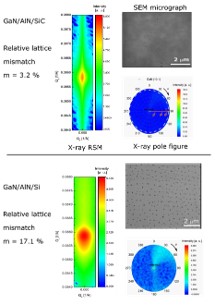 |
Highlights:
- The effect of the lattice mismatch in the dislocation density in heteroepitaxial GaN layers was assesed using X-ray reciprocal space maps, which show different broadening of the GaN spot.
- A different dislocation density is reflected in the SEM micrographs and X-ray absorption profiles. Grazing incidence X-ray diffraction was proposed as an alternative way to attest the presence of threading dislocations, which allowed us to study the X-ray propagation in our samples.
- These profiles can be used to get the depth profile of the dislocation density. In fact, it was revealed a different X-ray absorption for different substrates. In the case of Si substrate, where the dislocation density is the greateast, the X-rays are subjected to a strong absorption.
On the other hand, in the case of SiC substrate the X-ray absorption becomes smaller, which can be attributed to a smaller dislocation density.
- The results are further correlated with the broadening of the Raman modes and PL lines.
|
|
| |
4. „Ultrashallow defects in SiC MOS capacitors”, R. Pascu, Solid State Electronics Letters, 2, 79-84, 2020, doi: 10.1016/j.ssel.2020.11.001.
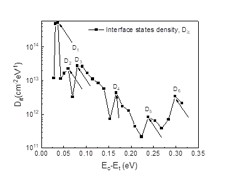 |
Highlights:
- SiC MOS capacitors have been fabricated and electrically investigated on a wide range of temperature between 14 –500 K;
- It was demonstrated that at a temperature of 420 K occurred a complete ionization of the donors dopants;
- An activation energy has been determined, having a value of 26.79 meV;
- The interface states density distribution on a wide range of energy levels has been determined, showing six peaks that can be related to the active electrical defects on both shallow and deeper levels in SiC band gap.
|
|
| |
5. “Optimizing the Tin Selenide (SnSe) Allotrope/Gold-Based Surface Plasmon Resonance Sensors for Enhanced Sensitivity”, Pericle Varasteanu, Plasmonics, First Online: 17 September (2020), doi: 10.1007/s11468-020-01255-y
Highlights:
- An optimization algorithm was employed alongside TMM to optimize the sensors response
- The reflectivity maps highlight the optimized structures’ configurations
- Excellent sensitivities in phase were obtained for SnSe modified structures for a variation of 0.0005 in sensing medium’s refractive index
- This work suggests that SnSe monolayers could be be part of the future highly sensitive SPR sensors
|
| |
6. “Novel DNA Biosensor Based on the Out-of-Equilibrium Body Potential Method in Silicon-on-Insulator”, Licinius Benea, Melania Popescu, Maryline Bawedin, Monica Simion, Irina Ionica, IEEE Sensors Journal20, 14032 - 14041, 2020. doi: 10.1109/JSEN.2020.3008133
Highlights:
- New sensing paradigm implemented in field-effect transistor-like structures;
- Reading based on out-of-equilibrium body potential in silicon-on insulator devices;
- Assessment of surface functionalization with physicochemical methods;
- Electrical response proportional to the DNA concentration;
- Detection limit obtained (≈ 1µM) can be greatly improved by device miniaturization.
|
| |
7. “Novel hybrid materials based on heteroleptic Ru(III) complexes immobilized on SBA-15 mesoporous silica as highly potent antimicrobial and cytotoxic agents”, Gabriela Marinescu, Dana Culita, Cosmin Romanitan, Simona Somacescu, Cristian Ene, Virgil Marinescu, Dragos Negreanu, Catalin Maxim, Marcela Popa, Luminita Marutescu, Miruna Stan, Carmen Chifiriuc, Applied Surface Science 520, 146379, 2020, doi: 10.1016/j.apsusc.2020.146379 |
| |
8. "Enhanced non-uniformity modeling of 4H-SiC schottky diode characteristics over wide high temperature and forward bias ranges", Gheorghe Brezeanu, Gheorghe Pristavu, Florin Draghici, Razvan Pascu, Francesco Della Corte, Simone Rascuna, IEEE Journal of the Electron Devices Society, vol. 8, pp. 1339-1344, 2020, doi: 10.1109/JEDS.2020.3032799 |
| |
9. “Efficient uptake and retention of iron oxide-based nanoparticles in HeLa cells leads to an effective intracellular delivery of doxorubicin”, Roxana C. Popescu, Diana Savu, I. Dorobantu, B. S. Vasile, H. Hosser, Adina Boldeiu, Mihaela Temelie, Mihai Straticiuc, D. A. Iancu, Ecaterina Andronescu, , F. Wenz, F.A. Giordano, C. Herskind, Marlon R. Veldwijk, Scientific Reports 10, 10530, 2020, doi: 10.1038/s41598-020-67207-y |
| |
10. “Enhanced internalization of nanoparticles following ionizing radiation leads to mitotic catastrophe in MG-63 human osteosarcoma cells”, Roxana C. Popescu, Mihai Straticiuc, Cosmin Mustaciosu, Mihaela Temelie, Roxana Trusca, Bogdan S. Vasile, Adina Boldeiu, Dragos Mirea Radu F. Andrei, Constantin Cenusa, Laurentiu Mogoanta, George D. Morosanu, Ecaterina Andronescu, Mihai Radu, Marlon R. Veldwijk, Diana I. Savu, International Journal of Molecular Sciences 21, 7220, 2020, doi: 10.3390/ijms21197220 |
| |
11. “Paraffin as a material for optical diffusers–Fabrication and characterization”, Gabriel Moagăr-Poladian, Alina Popescu, Doru Ursu, Raluca Gavrilă, Gabriel Crăciun, Cosmin Romaniţan, Iuliana Mihalache, Catalin Pârvulescu, Optical Materials 109, 110430, 2020, doi:10.1016/j.optmat.2020.110430 |
| |
12. “Evolution of microstructure and photoluminescence of ZnO thin films irradiated with 3 MeV alpha particles”, Rodica Plugaru, Ion Gruia, Raluca Gavrila, Cosmin Romanitan, Iuliana Mihalache, Anca Istrate, Nicolae Plugaru. Surfaces and Interfaces20, 100574. 2020, doi:10.1016/j.surfin.2020.100574 |
| |
13. „Properties of nitrogen-doped nano-crystalline graphite thin films and their application as electrochemical sensors”, Octavian Simionescu, Cosmin Romanitan, Camelia Albu, Cristina Pachiu, Eugeniu Vasile, Nikolay Djourelov, Oana Tutunaru, Marius C. Stoian, Mihaela Kusko, Antonio Radoi, Journal of the Electrochemical Society 167, 126510, 2020, doi: 10.1149/1945-7111/abb1d4 |
| |
14. “Electrochromic performance of V2O5 thin films grown by spray pyrolysis”, Kiriakos Mouratis, Valentin Tudose, Cosmin Romanitan, Cristina Pachiu, Oana Tutunaru, Mirela Suchea, Stelios Couris, Dimitra Vernardou, Emmanuel Koudamas, Materials 13, 3876, 2020, doi: 10.3390/ma13173859 |
| |
15. „The mechanical and physical properties of 3D-printed materials composed of ABS-ZnO nanocomposites and ABS-ZnO microcomposites”, Nectarios Vidakis, Marcos Petousis, Athena Maniadi, Emmanuel Koudoumas, George Kenanakis, Cosmin Romanitan, Oana Tutunaru, Mirela Suchea, John Kechagias, Micromachines 11, 615, 2020, doi: 10.3390/mi11060615 |
| |
16. „Effect of graphene nanoplatelets on the structure, the morphology, and the dielectric behavior of low-density polyethylene nanocomposites”, Athena Maniadi, Maria Vamvakaki, Mirela Suchea, Valentin Tudose, Marian Popescu, Cosmin Romanitan, Cristina Pachiu, Octavian Ionescu, Zaharias Viskadourakis, George Kenanakis, Emmanuel Koudamas, Materials 13, 4776, 2020, doi: 10.3390/ma13214776 |
| |
17. „Annealing effect on the properties of electrochromic V2O5 thin films grown by spray deposition technique”, Kyriakos Mouratis, Valentin Tudose, Andrianna Bouranta, Cristina Pachiu, Cosmin Romanitan, Oana Tutunaru, Stelios Couris, Mirela Suchea, Emmanuel Koudamas, Nanomaterials 10, 2397, 2020, doi: 10.3390/nano10122397 |
| |
18. „Effect of process parameters on YAG:Ce phosphor properties obtained by co-precipitation method”, Vasilica Ţucureanu, Cosmin Romanițan, Ioan Tudor, Catalin Ţucureanu, Melania Popescu, Alina Matei, Ceramics International 46, 23802–23812, 2020, doi: 10.1016/j.ceramint.2020.06.156. |
| |
19. “Photoluminescent carbon dots by o-phenylenediamine passivation of carbon nanoparticles”, Andreea Crisan, Ana Maria Craciun, Iuliana Mihalache, Monica Focsan, Crina Socaci, Dana Maniu, Simion Astilean, L. Monica Veca, Anamaria Terec,Revue Roumain de Chimie, 65(6), 559-566, 2020, doi: 10.33224/rrch.2020.65.6.05 |
| |
20. „Sonochemically synthetized ZnO-Graphene nanohybrids and its characterization”, CornelCobianu, Nicolae Dumbravescu, Bogdan Serban, Octavian Buiu, Cosmin Romanitan, Florin Comanescu, Mihai Danila, Roxana Marinescu, Viorel Avramescu, Octavian Ionescu, Reviews on Advanced Materials Science 59, 176–187, 2020, doi: 10.1515/rams-2020-0013 |
| 2019 |
|
| |
1. “Transition metal dichalcogenides/gold based surface plasmon resonance sensors: exploring the geometrical and material parameters”, Pericle Varasteanu, Plasmonics, First Online: 12 September 2019 (.pdf)
Highlights:
- The response of various 2D TMDC modified SPR based sensors configurations was systematically studied by computing the SPP dispersion relations and reflectivity maps.
- Dispersion relations showed a promising addition to reflectivity maps in gaining insight about mechanisms that improve the sensor’s response.
- The analyses showed that sensors’ response, both in intensity and phase, was greatly enhanced by coating the gold surface with 2D TMDC monolayers.
|
 |
|
| |
2. “Unravelling the strain relaxation processes in silicon nanowire arrays by X‐ray diffraction”, Cosmin Romanitan, Mihaela Kusko, Marian Popescu, Pericle Varasteanu, Antonio Radoi, Cristina Pachiu, Journal of Applied Crystallography, First published: 06 September 2019 (.pdf)
Highlights:
- A reliable and non-destructive X-ray laboratory formalism was developed to allow local examination along nanowires length that can be exploited to obtain finally the in-depth strain map and a quantitative description of the transfer energy processes between nanowires and dislocations.
- Thus, if in most cases, the X-rays diffraction studies concerning the strain in nanowires systems employ synchrotron X-ray sources, our formalism enables us to build unambiguously the bending and torsion profiles and to gain a quantitative description of the relaxation processes in connection with their morphological features using laboratory X-ray diffraction experiments.
|
 |
|
| |
3. “Comparative analysis of honey and citrate stabilized gold nanoparticles: In vitro interaction with proteins and toxicity studies”, Adina Boldeiu, Monica Simion, Iuliana Mihalache, Antonio Radoi, Melania Banu, Pericle Varasteanu, Paul Nadejde, Eugeniu Vasile, Adriana Acasandrei, Roxana Cristina Popescu, Diana Savu, Mihaela Kusko, Journal of Photochemistry and Photobiology B: Biology, 111519, Available online 5 June (pdf)
Highlights:
- The colloidal behaviour of AuNPs@citrate and AuNPs@honey in two commonly used cell media, was physico-chemical analyzed.
- Protein corona individually covering the nanoparticles, was observed, for both cell media.
- DMEM promotes more abundant agglomerations, clustering together the nanoparticles in protein matrix.
|
 |
|
| |
4. “Tunable photoluminescence from interconnected graphene network with potential to enhance the efficiency of a hybrid Si nanowire solar cell”, Iuliana Mihalache*, Alexandra Purcarea, Eugeniu Vasile, Cristina Pachiu, Sandra A. V. Eremia, Antonio Radoi*, Mihaela Kusko, Physical Chemistry Chemical Physics, 21, 9564-9573 (pdf)
Highlights:
- We report the synthesis of a novel tunable photoluminescent carbonaceous material based on arrangements of agglutinated short-range ordered graphene-like nanosheets which we call interconnected graphene network (IGN) using a one-pot microwave-assisted hydrothermal carbonization route.
- Furthermore, we explored IGN potential as optoelectronic material by fabricating the IGN/p-SiNWs radial heterojunction solar cell via scalable and versatile potentiostatic electrochemical deposition technique.
- The new architecture showed the best performance with an overall enhancement of power conversion efficiency of 7.5 times higher than the reference cell, indicating that further IGN exploitation may help to gain efficiency in future energy conversion applications.
|
 |
 |
|
|
| |
5. "Electron-phonon coupling as the source of 1/f noise in carbon soot”, Mihai Mihaila, Doru Ursutiu, Ion Sandu, Scientific Reports 9, Article number: 947, 2019 (pdf)
Highlights:
- Noise peaks were observed at Kohn anomalies in a carbon soot resistor. Their presence was exploited to demonstrate that electron-phonon coupling is the microscopic source of 1/f noise;
- A new, general and simple formula was found for the frequency exponent, wherein nonlinearity and dispersion are the only ingredients;
- The 1/f noise parameter is the image of the matrix element squared. It was used to explain the puzzling M-shape of the 1/f noise in graphene in terms of electron-phonon coupling;
|
 |
- A fine structure in the frequency exponent mimics the voltage dependence of the noise intensity, while both are the image of the graphite phonon spectrum. This structure strongly correlates with the specific energies of the out-of-plane atomic motion in graphite/graphene (Z phonons). It unraveled the electron-phonon interaction as the unique source responsible for the structure in both noise intensity and the frequency exponent;
- It means that the source of nonlinearity is in the electron-phonon coupling which modulates the slope of the spectrum. This implies that 1/f noise exists in the thermal noise background of the resistor till phonon frequencies;
- It requires a classic-quantum crossover, above which Planck's blackbody radiation law is valid (equipartition breakdown). Consequently, 1/f noise is not a low frequency effect, as considered for almost a century.
|
|
| |
6. “A reliable technology for advanced SiC-MOS devices based on fabrication of high quality silicon oxide layers by converting a-Si”, Razvan Pascu, Cosmin Romanitan, Pericle Varasteanu, Mihaela Kusko, IEEE Journal of the Electron Devices Society, 7 , 158 – 167, 2019 (pdf)
Highlights:
- An alternative technological approach is proposed to obtain a SiO2 film on SiC using processes that finally reduce the effective fabrication costs.
- We demonstrated that using a two-step process, consisting in depositing of an a-Si thin film by room temperature sputtering followed by oxidation, represents a valuable technological approach for fabrication of an oxide layer for SiC-MOS type devices, in terms of both technological steadiness and structure quality.
- The improvement of the oxide/semiconductor interface was further validated by the electrical investigation of the fabricated MOS structures, where a significant diminishing of the effective oxide charge density, interface traps density, and near interface oxide traps density was assessed.
|
 |
| 7. “Synthesis and characterization of Ca doped ZnO thin films by sol-gel method”, Anca-Ionela Istrate, Florin Nastase, Iuliana Mihalache, Florin Comanescu, Raluca Gavrila, Oana Tutunaru, Cosmin Romanitan, Vasilica Tucureanu, Monica Nedelcu, Raluca Müller, Journal of Sol-Gel Science and Technology, Early Access: OCT., 2019 (.pdf) |
| 8. “RF magnetron sputtering deposition of TiO2 thin films in a small continuous oxygen flow rate”, Octavian-Gabriel Simionescu, Cosmin Romanițan, Oana Tutunaru, Valentin Ion, Octavian Buiu, Andrei Avram, Coatings 9(7), 442, 2019 (.pdf) |
| 9. “Physical properties of the ferroelectric capacitors based on Al-doped HfO2 grown via Atomic Layer Deposition on Si”, Silviu Vulpe, Florin Nastase Mircea Dragoman, Adrian Dinescu, Cosmin Romanitan, Sorina Iftimie, Antoniu Moldovan, Nicoleta Apostol, Applied Surface Science 483, 324-333, 2019 (.pdf) |
| 10. “Dataset on large area nano-crystalline graphite film (NCG) grown on SiO2 using plasma-enhanced chemical vapour deposition”, Camelia Albu, Sandra A.V. Eremia, Monica Lucia Veca, Andrei Avram, Radu Cristian Popa, Cristina Pachiu, Cosmin Romanitan, Mihaela Kusko, Raluca Gavrila, Antonio Radoi, Data in Brief 24, 103923, 2019 (.pdf) |
| 11. “Antibacterial efficiencyof cellulose-based fibers covered with ZnO and Al2O3 by atomic layer deposition”, Marian C. Popescu, C.Ungureanu, E.Buse, Florin Nastase, Veronica Tucureanu, Mirela Sucheaa, S. Dragad, Melania A. Popescu*, Applied Surface Science 481, 1287-1298, 2019 (pdf) |
|
| 12. “Enhancing the microarray signal detection of single nucleotide polymorphisms (SNPs) by using homemade immobilisation buffers”, Melania Banu, Monica Simion, Mihaela Kusko, Ileana Cornelia Farcasanu, Revista de Chimie 70, 730-735, 2019 (pdf) |
| 13. “400°C Sensor Based on Ni/4H-SiC Schottky Diode for Reliable Temperature Monitoring in Industrial Environments”, Florin Draghici, Gheorghe Brezeanu, Gheorghe Pristavu, Razvan Pascu, Marian Badila, Adriana Pribeanu, Emilian Ceuca, Sensors 19(10), 2384 (pdf) |
| 14. “Heteroatom-mediated performance of dye-sensitized solar cells based on T-shaped molecules”, Mariana-Dana Damaceanu, Catalin-Paul Constantin, Andra-Elena Bejan, Mihai Mihaila, Mihaela Kusko, Cristian Diaconu, Iuliana Mihalache, Razvan Pascu, Dyes and Pigments 166, 15-31, 2019 (pdf) |
| 15. “Characterization of non-uniform Ni/4H-SiC Schottky diodes for improved responsivity in high-temperature sensing”, Gheorghe Pristavu, Gheorghe Brezeanu, Razvan Pascu, Florin Drăghici, Marian Bădilă, Materials Science in Semiconductor Processing 94, 64-69 (2019). (pdf) |
| 16. “Nano-crystalline graphite film on SiO2: Electrochemistry and electro-analytical application”, Camelia Albu, Sandra A.V. Eremia, Monica Lucia Veca, Andrei Avram, Radu Cristian Popa, Cristina Pachiu, Cosmin Romanitan, Mihaela Kusko, Raluca Gavrila, Antonio Radoi*, Electrochimica Acta 303, 284-292 (2019). (pdf) |
| 17. “Influence of surface substrates on the properties of ZnO nanowires synthesized by hydrothermal method“, Paula Obreja, Dana Cristea, Adrian Dinescu, Cosmin Romanitan, Applied Surface Science 463, 1117-1123 (2019). (pdf) |
| 18. “Influence of Cu dopant on the morpho-structural and optical properties ZnO nanoparticles”, Alina Matei, Veronica Tucureanu, Marian Popescu, Cosmin Romanitan, Iuliana Mihalache, Ceramics International 45, 10826-10833 (2019). (pdf) |
| 19. “Physical properties of the ferroelectric capacitors based on Al-doped HfO2 grown via Atomic Layer Deposition on Si”, Silviu Vulpe, Florin Nastase, Mircea Dragoman, Adrian Dinescu, Cosmin Romanitan, Sorina Iftimie, Antoniu Moldovan, Nicoleta Apostol, Applied Surface Science Available online 22 March (2019). (pdf) |
| 20. ”Effect of Silicon Surface Cleaning on Electrical Properties of As-Deposited Atomically Layer-Deposited (ALD) HfO2 Films Obtained From Tetrakis(dimethylamino)Hafnium (TDMAH) and Water”, Cornel Cobianu, Florin Nastase, Niculae Dumbravescu, Octavian Buiu, Bogdan Serban, Mihai Danila, Raluca Gavrila, Octavian Ionescu, Cosmin Romanitan, Romanian Journal of Information Science and Technology22,41-56 (2019). (pdf) |
| 2018 |
|
| |
1. "High-performance solid state supercapacitors assembling graphene interconnected networks in porous silicon electrode by electrochemical methods using 2,6-dihydroxynaphthalen”, Cosmin Romanitan, Pericle Varasteanu, Iuliana Mihalache, Daniela Culita, Simona Somacescu, Eugenia Tanasa, Sandra A. V. Eremia, Adina Boldeiu, Monica Simion, Antonio Radoi*, Mihaela Kusko*, Scientific Reports 8, Article number: 9654, 2018. (pdf) |
Highlights:
- Herein we demonstrate the achievement of an easy scalable technology for solid state supercapacitors on silicon, with excellent electrochemical properties.
- The conformal modification of the ultra-high internal surface of nanoporous silicon was tackled by electrochemical polymerisation of 2,6-dihydroxynaphthalene using cycling voltammetry or potentiometry and, notably, after the thermal treatment (800 °C, N2, 4h) an assembly interconnected networks of graphene strongly adhering to nanoporous silicon matrix resulted.
|
 |
- Both devices (NC_CV-SSC and NC_J-SSC) present outstanding results at a large operational potential windows of 2.1 V, the hierarchical, hybrid pore structure with short diffusional paths, being able to handle ultra-high rates for voltage sweep, 5 V/s, or discharge current density, 100 A/g, respectively.
- It is notable that whereas NC_CV-SSC distinguishes as ultra-high power delivering (53.8 kW/kg), the NC_J-SSC exhibits high specific capacity of 162.4 F/g at 1 A/g and ultra-high energy density 24.8 Wh/kg.
|
|
| |
| |
2. "Specific detection of stable single nucleobase mismatch using SU-8 coated silicon nanowires platform", Melania Banu, Monica Simion, Marian C. Popescu, Pericle Varasteanu, Mihaela Kusko, Ileana C. Farcasanu, Talanta 185, 281–290, 2018. (pdf)
|
Highlights:
- This work employed a novel analytical platform for Single Nucleotide Polymorphism (SNP) detection and genotyping applications, using silicon nanowires as substrate and a simplified surface modification procedure with epoxy-based SU-8 photoresist.
- SiNWs were configured by 1-MACE and APTES + GAD and SU-8 coatings were used for attaching BRCA1-corresponding sequences with stable mismatch types.
- Enhanced reproducibility and high detection specificity on SU-8/SiNWs biochip was demonstrated by CV and ANOVA test and very good SSDR was calculated for GAD/SiNWs and SU-8/SiNWs platform is comparable with the commercial support.
|
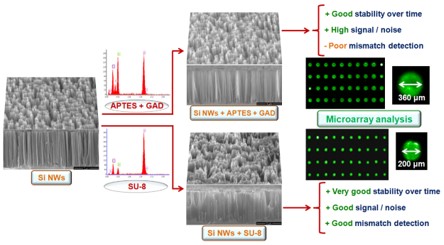 |
- The proposed strategy holds a great promise for medical diagnosis based on microarray technology due to both good control in spot morphology and a clear distinction between the stable mismatch types.
- The high specificity of the probes has been proved over the time by the comprehensive statistical approach, asserting its suitability for commercial purposes.
|
| 3. “2.55 GHz miniaturised phased antenna array based on 7 nm-thick Hf x Zr1 − x O2 ferroelectrics”, Mircea Dragoman, Mircea Modreanu, Ian M. Povey, Sergiu Iordanescu, Martino Aldrigo, Adrian Dinescu, Dan Vasilache, Cosmin Romanitan, Electronics Letters 54, 469-470, 2018 (pdf) |
| 4. “Accumulation of Ag(I) by Saccharomyces cerevisiae cells expressing plant metallothioneins”, Lavinia L. Ruta, Melania A. Banu, Aurora D. Neagoe, Ralph Kissen, Atle M. Bones, Ileana C. Farcasanu, Cells, 7, 266-14p., 2018 (pdf) |
| 5. “Current rectification effects in 6 nm thick HfxZr1-xOyferroelectrics/Si planar heterostructures“, Mircea Dragoman, Mircea Modreanu, Ian M. Povey, Sergiu Iordanescu, Martino Aldrigo, Adrian Dinescu, Dan Vasilache, Cosmin Romanitan, Daniela Dragoman, Physica E: Low-Dimensional Systems and Nanostructures 104, 241-246, 2018 (pdf) |
| 6. “Synthesis of macroporous ZnO-graphene hybrid monoliths with potential for functional electrodes“, Lucia M. Veca, Florin Nastase, Cristina Banciu, Marian Popescu, Cosmin Romanitan, Marius Lungulescu, Radu Popa, Diamond and Related Materials 87, 70-77, 2018 (pdf) |
| 7. “Superficial and inner examination of a microwave-irradiated dental acrylic resin and its metal–polymer interface”, Marian C. Popescu, Bogdan I. Bita, Vasilica Tucureanu, Dan Vasilache, Melania A. Banu, Andrei M. Avram, Raluca A. Giurescu-Dumitrescu, Microscopy and Microanalysis 24, 49-59, 2018 (pdf) |
| 8. “1D nanostructured ZnO layers by microwave - Assisted hydrothermal synthesis”, Viorica Musat, Ana Filip, Nicolae Tigau, R odica Dinica, Elena E. Herbei, Cosmin Romanitan, Iuliana Mihalache, Munizer Purica, Revista de Chimie 69, 2788-2793, 2018 (pdf) |
| |
 |
| 2017 |
|
| |
1. „Correlation between threading dislocations in highly mismatched GaN heteroepitaxial layers”, Cosmin Romanitan, Solid State Communications, 268, 51-55, 2017 (pdf)
 |
Highlights:
- A simplified method was proposed to obtain threading dislocations correlation degree for screw component (left) and for edge component (right) using XRD data.
- A new parameter – S – was obtained and validated for GaN/sapphire heteroepitaxial layers, starting from the integral area where the rocking curve profiles are consistent with Gauss shape (red zone).
- The S parameter is a quantitative measure of the positional correlation between threading dislocations.
- The method might be applied to high mismatch heteroepitaxial systems and to heterostructures with based on ternary compounds.
|
|
| |
2. „Engineering Graphene Quantum Dots for Enhanced Ultraviolet and Visible Light p-Si Nanowire-Based Photodetector”, Iuliana Mihalache*, Antonio Radoi, Razvan Pascu, Cosmin Romanitan, Eugenia Vasile, Mihaela Kusko*, ACS Appl. Mater. Interfaces, Article ASAP, 9 (34), pp 29234–29247, 2017 (pdf)
|
Highlights:
- In this work, a significant improvement of the classical silicon nanowire (SiNW)-based photodetector was achieved through the realization of core–shell structures using newly designed GQDPEIs via simple solution processing.
- The poly(ethyleneimine) (PEI)-assisted synthesis successfully tuned both optical and electrical properties of graphene quantum dots (GQDs) to fulfill the requirements for strong yellow photoluminescence emission along with large band gap formation and the introduction of electronic states inside the band gap.
- The GQDPEI/SiNW photodetector exhibited a large photocurrent to dark current ratio (Iph/Idark up to ∼0.9 × 102 under 4 V bias) and a remarkable improvement of the external quantum efficiency values that far exceed 100%.
- In this frame, GQDPEIs demonstrate the ability to arbitrate both charge-carrier photogeneration and transport inside a heterojunction, leading to simultaneous attendance of various mechanisms: (i) efficient suppression of the dark current governed by the type I alignment in energy levels, (ii) charge photomultiplication determined by the presence of the PEI-induced electron trap levels, and (iii) broadband ultraviolet-to-visible downconversion effects.
|
|
| |
3. “Oxide trap states versus gas sensing in SiC-MOS capacitors – the effect of N- and P- based post oxidation processes”, Razvan Pascu*, Florea Craciunoiu, Gheorghe Pristavu, Gheorghe Brezeanu, Mihaela Kusko*, Sensors and Actuators B: Chemical 245, 911–922, 2017 (pdf)
 |
Highlights
• A comparative in-depth analysis of the N or P based post oxidation annealing (POA) effects on both the Pd/SiO2/SiC structure parameters and the hydrogen sensing performances was performed.
• The interface states density was reduced with more than one order of magnitude in the case of POCl3 MOS structure.
• We demonstrate that a short N2-POA process (6 min., 1100 °C) is sufficient to improve the gate oxide quality and to significantly enhance the device response as hydrogen sensor.
• We achieved the response/recovery times of 10/11 s for 20 ppm of hydrogen, with 0.77 ppm detection limit and 50.3 pF calibration sensitivity, respectively. |
|
|
| |
4. “Comparative study of threading dislocations in GaN epitaxial layers by nondestructive methods”Cosmin Romanitan*, Raluca Gavrila, Mihai Danila*, Materials Science in Semiconductor Processing 57, 32-38, 2017 (pdf)
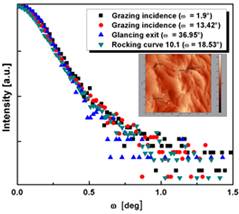 |
Highlights
• We report a comprehensive analysis of two high mismatched heteroepitaxial GaN layers based on nondestructive methods, AFM and XRD;
• While AFM provided a qualitative view of the dislocation density, the XRD techniques allowed us an in-depth study.
• It was found that interface between substrate and layer is the primary source for dislocations and layer does’t contain nucleation or annihilation centers for threading dislocations, therefore dislocation density is constant in the depth of the layer. |
|
| |
5. "Electromodulation spectroscopy of heavy-hole, light-hole, and spin-orbit transitions in GaAsBi layers at hydrostatic pressure”, Filip Dybała, Jan Kopaczek, Marta Gladysiewicz, Emil.-Mihai Pavelescu, Cosmin Romanitan, Octavian Ligor, Alexandre Arnoult, Chantal Fontaine, Robert Kudrawiec, Applied Physics Letters111, 192104, 2017 (pdf)
|
| |
6. "Pan-European inter-laboratory studies on a panel of in vitro cytotoxicity and pro-inflammation assays for nanoparticles",
Jean-Pascal Piret, Olesja M. Bondarenko, Matthew S. P. Boyles, Martin Himly, Ana R. Ribeiro, Federico Benetti, Caroline Smal, Braulio Lima, Annegret Potthoff, Monica Simion, Elise Dumortier, Paulo Emilio C. Leite, Luciene Bottentuit Balottin, José Mauro Granjeiro, Angela Ivask, Anne Kahru, Isabella Radauer-Preiml, Ulrike Tischler, Albert Duschl, Christelle Saout, Sergio Anguissola, Andrea Haase, An JacobsInge Nelissen, Superb K. Misra, Olivier Toussaint, Archives of Toxicology 91, 2315–2330, 2017 (pdf) |
| |
7. “Very large phase shift of microwave signals in a 6 nm HfxZ1-xrO2 ferroelectric at ±3V”, Mircea Dragoman, Mircea Modreanu, Ian M Povey, Sergiu Iordanescu, Martino Aldrigo, Cosmin Romanitan, Dan Vasilache, Adrian Dinescu, Daniela Dragoman, Nanotechnology, online 4 August 2017 (pdf) |
| |
8. "Characterization technique for inhomogeneous 4H-SiC Schottky contacts: a practical model for high temperature behavior", Gheorghe Brezeanu, Gheorghe Pristavu, Florin Draghici, Marian Badila, Razvan Pascu, Journal of Applied Physics 122, 084501, 2017 (pdf) |
| |
9. “Fabrication and cytotoxicity of gemcitabine-functionalized magnetite nanoparticles”, Roxana Popescu, Ecaterina Andronescu, Bogdan Ș. Vasile, Roxana Truşcă, Adina Boldeiu, Laurențiu Mogoantă, George D. Mogoșanu, Mihaela Temelie, Mihai Radu, Alexandru Mihai Grumezescu, Diana Savu, Molecules22 (7):1080 (pdf) |
| |
 |
| |
|
| 2016 |
|
| |
1. “A new 4H-SiC hydrogen sensor with oxide ramp termination”, Razvan Pascu, Mihaela Kusko, Florea Craciunoiu, Gheorghe Pristavu, Gheorghe Brezeanu, Marian Badila, Viorel Avramescu, Materials Science in Semiconductor Processing 42 (2), 268-272, 2016 (pdf)
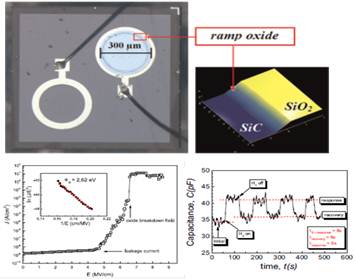 |
Highlights
• We report a Pd/SiO2/4H-SiC MOS capacitor fabricated using a new configuration with an oxide ramp termination that enables short response and recovery times when it is used as hydrogen sensor.
• The H2 detection performances of the test structures were analyzed at concentrations ranging from 20 to 10,000 ppm at operating temperatures up to 450K, showing the best results at 450K. |
|
| |
2. "On the 1/f Noise and Energy Partition in Solid", M. Mihaila, Romanian Journal of Information
Science and Technology 19 (1-2), 175-187, 2016
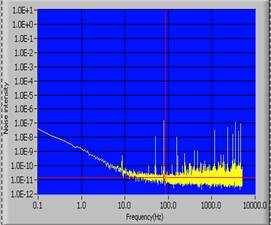 |
Highlights
- Microscopic origin of 1/f or 1/f-like noise, also known as infrared catastrophe, remained unknown since its discovery, more than 90 years ago. It manifests in solids, liquids, biological systems, etc. and acts as the fundamental source of decoherence in quantum computing. In this work, we heuristically analyze apparently dissimilar aspects related to the 1/f noise in solid, with the purpose to reveal possible hidden but unifying factors involved in the microscopic mechanism of 1/f noise in solid.
|
- We found that the microscopic nonlinearity is a sine qua non condition for the existence of both thermal and 1/f noise. Violation of the equipartition law is required to have 1/f noise.
|
|
| |
3. “Molybdenum disulphide and graphene quantum dots as electrode modifiers for laccase biosensor”, Ioana Vasilescu, Sandra A.V. Eremia, Mihaela Kusko, Antonio Radoi, Eugen Vasile, Gabriel-Radu Lucian, Biosensors and Bioelectronics 75, 232-237, 2016 (pdf) |
| |
4. „Ballistic electron propagation through periodic few-layer graphene nanostructures” Daniela Dragoman*, Iulia Mihalache, Physica E: low-dimensional systems and nanostructures, 84, 60-70, 2016 (pdf) |
| |
5. “Surface passivation of carbon nanoparticles with p-phenylenediamine towards photoluminescent carbon dots”, Ana M. Craciun, Andreea Diac, Monica Focsan, Crina Socaci, Klara Magyari, Dana Maniu, Iuliana Mihalache, Lucia M. Veca* S. Astilean*, A. Terec*, RSC Advances, 6, 56944-56951, 2016 (pdf) |
| |
 |
| |
|
| 2015 |
|
| |
1. “Enhanced nucleotide mismatch detection based on a 3D silicon nanowire microarray”, Melania Banu, Monica Simion, Attila C. Ratiu, Marian Popescu, Cosmin Romanitan, Mihai Danila, Antonio Radoi, Alexandru Al. Ecovoiu, Mihaela Kusko, RSC Advances 5, 74506-74514, 2015 (pdf)
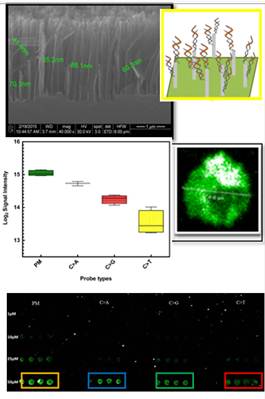 |
Highlights
• Herein, we report the development of a silicon-based substrate as a microarray platform for the investigation of SNPs with pathological significance.
• The aim of our study was to investigate single nucleotide polymorphisms (SNPs) with pathological significance within breast cancer 1, early onset gene (BRCA1).
• The developed platform allows a statistically significant discrimination of the hybridization signal intensities when the DNA probes differ by the presence of one mismatch in a selected position. These achievements are attributed to the facilitated target molecules' access to the attached probes due to the three-dimensional (3D) architecture of the support and to the antireflective properties of the SiNWs substrate.
• Based on these results, it is reasonable to assume that the functionalised SiNWs substrate represents an adequate microarray platform to discriminate the hybridization results depending on the identity of mispairs. |
|
| |
2. “Charge and energy transfer interplay in hybrid sensitized solar cells mediated by graphene quantum dots”, Iuliana Mihalache, Antonio Radoi*, Mihai Mihaila, Cornel Munteanu, Alexandru Marin,Mihai Danila, Mihaela Kusko*, Cristian Kusko, Electrochimica Acta 153, 306–315, 2015 (pdf)
 |
Highlights
• We report a one pot synthesis metod of GQD with controlled size and optoelectronic properties.
• An improvement of common N3-DSSC characteristics is achieved when GQDs are used as co-sensitiser.
• The role of GQD as cosensitisers in hybrid DSSC was investigated and the interplay between charge and energy transfer phenomena mediated by GQDs was demonstrated.
• The GQDs presence determines an inhibition of the recombination processes at the TiO2/electrolyte interface. |
|
| |
3. “A model to non-uniform Ni Schottky contact on SiC annealed at elevated temperatures”, Gheorghe Pristavu, Gheorghe Brezeanu, Marian Badila, Razvan Pascu, Mihai Danila, P. Godignon, Applied Physics Letter 106, 261605, 2015 (pdf) |
| |
4. “A new sensitizer containing dihexyloxy-substituted triphenylamine as donor and a binary conjugated spacer for dye-sensitized solar cells”, Mariana Dana Damaceanu, Mihai Mihaila, Catalin-Paul Constantin, Stefan Chisca, Bogdan-Catalin Serban, Cristian Diaconu, Octavian Buiu, Emil M Pavelescu, Mihaela Kusko, RSC Advances, 5, 53687-53699, 2015 (pdf) |
| |
5. “Hetero-epitaxial growth of TiC films on MgO(001) at 100 °C by DC reactive magnetron sputtering”, M. Braic, N.C. Zoita, M. Danila, C.E.A. Grigorescu, C. Logofatu, Thin Solid Films, 589, 590-596 2015 (pdf) |
| |
6. "An electrochemical DNA-based biosensor to study the effects of CdTe quantum dots on UV-induced damage of DNA", Lenka Hlavata, Ivana Striesova, Teodora Ignat, Jana Blaskovisova, Branislav Ruttkay-Nedecky, Pavel Kopel, Vojtech Adam, Rene Kizek, Jan Labuda, Microchimica Acta,
182, 1715-1722, 2015(pdf) |
| |
7. “MWCNT of different physicochemical properties causes similar inflammatory responses, but differences in transcriptional and histological markers of fibrosis in mouse lungs”, Sarah S. Poulsena, Anne T. Sabera, Andrew Williams, Ole Andersen, Carsten Købler, , Rambabu Atluri, Maria E. Pozzebon, Stefano P. Mucelli, Monica Simion, David Rickerby, Alicja Mortensen, Petra Jackson, Zdenka O. Kyjovska, Kristian Mølhave, Nicklas R. Jacobsen, Keld A. Jensen, Carole L. Yauk, Håkan Wallin, Sabina Halappanavar, Ulla Vogel, Toxicology and Applied Pharmacology, 284, 16–32, 2015 (pdf) |
| |
8. “Synthesis and characterization of YAG:Ce,Gd and YAG:Ce,Gd/PMMA nanocomposites for optoelectronic applications”, Vasilica Tucureanu, Alina Matei, Iuliana Mihalache, Mihai Danila, Marian Popescu, Bogdan Bita, Journal of Materials Science, 50(4), 1883-1890, 2015 (pdf) |
| |
9. “Study of the influence of capping agents on the structural and optical properties of ZnO nanostructures”, A. Matei, L. Dumitrescu, I. Cernica, V. Tucureanu, I. Mihalache, B. Bita, M. Danila, I. Manciulea, Journal of Optoelectronics and Advanced Materials 17 (7-8), 952 – 957, 2015 (pdf) |
| |
“Material characterizations for mems vibration sensors and biostructures applications”, R. Voicu, A. Baracu,, R. Gavrila, C. Obreja, M. Danila, A. Dinescu, B. Bita, R. Müller, Digest Journal of Nanomaterials and Biostructures 10 (3), 1077 – 1085, 2015; |
| |
 |
| |
|
| 2014 |
|
| |
1. “Nafion based nanocomposite membranes with improved electric and protonic conduction”, Adina Boldeiu, Eugeniu Vasile, Raluca Gavrila, Monica Simion, Antonio Radoi, Alina Matei, Iuliana Mihalache, Razvan Pascu, Mihaela Kusko*, Colloids and Surfaces A: Physicochem. Eng. Aspects, 461 133–141, 2014 (pdf)
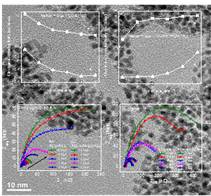 |
Highlights
• A nanocomposite membrane was obtained based on Nafion with PtNP–GN–PDDA/PSS multilayers
• Charge transport characteristics (EIS) were analyzed during the assembling process.
• Improved nanocomposite multilayer structures with simultaneously proton and electron conduction. |
|
2. “Memory effect in carbon quantum dot – PEG1500N composites”, Iulia Mihalache, L. Monica Veca, Mihaela Kusko, Daniela Dragoman*,Current Applied Physics 14, 1625-1632, 2014 (pdf)
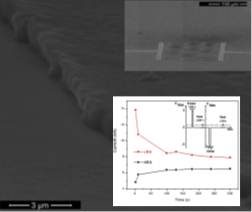 |
Highlights
• Bare and PEG1500N functionalized carbon quantum dots show resistance hysteresis.
• Both systems show stable memory effect after large cycle number.
• Only functionalized carbon quantum dots show stable hysteresis with temperature.
• Transport mechanisms responsible for hysteresis were identified for both systems. |
|
3. “Pt nanoparticles on graphene e polyelectrolyte nanocomposite: Investigation of H2O2 and methanol electrocatalysis”, Adina Bragaru, Eugeniu Vasile, Cosmin Obreja, Mihaela Kusko, Mihai Danila, Antonio Radoi*, Materials Chemistry and Physics 146, 538-544, 2014 (pdf)
 |
Highlights
• Hybrid nanocomposite for H2O2 and methanol electrocatalysis.
• A good coverage of PtNPs on graphene polyelectrolyte composite was obtained.
• The efficiency for PtNPs-GO-PDDA is similar to commercially available catalysts.
• Good tolerance towards carbonaceous species during methanol oxidation. |
|
4. “Charge storage and memory effect in graphene quantum dots – PEG600 hybrid nanocomposite”, I. Mihalache, A. Radoi, C. Munteanu, M. Kusko, C. Kusko*, Organic Electronics 15, 216–225, 2014 (pdf)
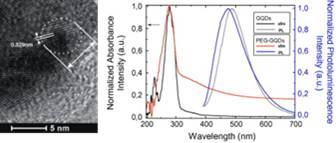
 |
Highlights
• We report the optical and electrical properties of the GQDs – PEG600 composite.
• A large clockwise hysteresis presenting high and low resistance states is obtained.
• Two distinctive regions of negative differential resistance with the peak to valey ratios of 2.2 and 1.3 are observed.
• Upon light excitation the structures show a significant photosensitivity.
• A large charge storage and memory effect based on GQDs – PEG600 composite are demonstrated.
|
|
5. “Gold nano-island arrays on silicon as SERS active substrate for organic molecule detection”, T. Ignat, M.-A. Husanu, R. Munoz, M. Kusko, M. Danila, C. M. Teodorescu, Thin Solid Films, 550, 354–360, 2014 , (pdf)
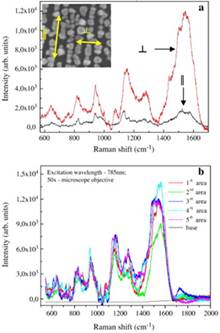
|
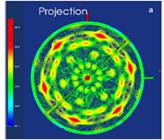
Highlights
• Gold islands forming highly controlled arrays have been fabricated by two potential step electrochemical deposition method using nanopatterned Si surface templates.
• Besides the appropriate management of nano-island arrays distribution, the high ratio of their Raman signals can be explain by the epitaxial-like growth mechanism of the metallic nano-islands, clearly showed by X-ray diffraction studies. |
|
6. “POCl3 Annealing Effect on The Flat Band Voltage Instabilities for a SiC Based MOS Capacitor at High Temperature”,Razvan Pascu, Gheorghe Pristavu, Florea Craciunoiu, Marian Badila, Mihaela Kusko, Gheorghe Brezeanu, Jenica Neamtu, Raluca Gavrila, Romanian Journal of Information Science and Technology 17 (4), 340–352, 2014 (pdf)
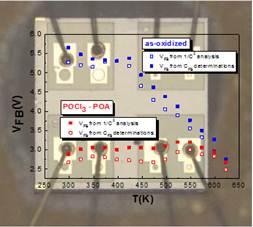 |
Highlights
• We report achieving of an improved stability of the flat band voltage with temperature of Pd/SiO2/4H-SiC MOS capacitor when an additional POCl3 based post oxidation annealing treatment is performed.
• While the as-oxidized structures show a linear decrease of VFB after 423 K, the POA leads to an increase of the temperature range where VFB is approximately constant (up to 623 K). |
|
| 7. “Charge transport and memristive properties of graphene quantum dots embedded in poly(3-hexylthiophene) matrix”, Alexandru Cosmin Obreja, Dana Cristea, Iuliana Mihalache, Antonio Radoi, Raluca Gavrila, Florin Comanescu, and Cristian Kusko*, Applied Physics Letters 105, 083303, 2014 (pdf) |
| 8. “Influence of film thickness on the morphological and electrical properties of epitaxial TiC films deposited by reactive magnetron sputtering on MgO substrates”, N.C. Zoita, V. Braic, M. Danila, A.M. Vlaicu, C. Logofatu, C.E.A. Grigorescu, M. Braic, Journal of Crystal Growth 389 92–98, 2014 (pdf) |
| 9. “Electroluminescence of carbon ‘quantum’ dots – From materials to devices, to devices” L. Monica Veca*, Andreea Diac, Iuliana Mihalache, Ping Wang, Gregory E. LeCroy, Emil Mihai Pavelescu, Raluca Gavrila, Eugeniu Vasile, Anamaria Terec, Ya-Ping Sun, Chem. Phys. Letter 613, 40-44, 2014 (pdf) |
| |
 |
| |
|
| 2013 |
|
| |
1. “Dual detection biosensor based on porous silicon substrate”, M. Simion, M. Kusko, I. Mihalache, A. Bragaru, Materials Science and Engineering B 178, 1268– 1274, 2013 (pdf)
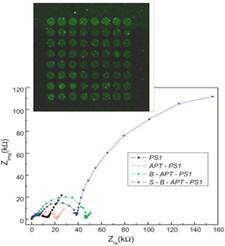
|
Highlights
• A dual detection method for protein recognition processes was developed on different nanostructured silicon substrates, based on using two complementary spectroscopic techniques: fluorescence and electrochemical impedance.
• The label free electrochemical impedance analyses shown that the extension of the active sensor area due to the nanoporous structure increases the measured capacitance and thus allows a scaling down of the sensor. |
|
2. “Microstructures and growth characteristics of polyelectrolytes on silicon using layer-by-layer assembly”, A. Bragaru, M. Kusko, A. Radoi, M. Danila, M. Simion, F. Craciunoiu, R. Pascu, I. Mihalache, T. Ignat, Central European Journal of Chemistry, 11(2), 205-214, 2013 (pdf)
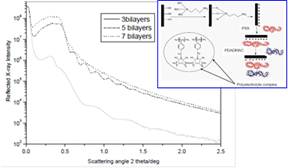
|
Highlights
• Multilayer structures were obtained on Si by polyelectrolyte layer-by-layer assembly.
• The growth process is analyzed by different instrumental techniques.
• Both electrophoretic zeta potential measurements, ATR-IR spectroscopy and X-ray reflectivity confirmed the building up of the nanocomposite layer. |
|
3. “Analytical characterization of engineered ZnO nanoparticles relevant for hazard assessment”, A. Bragaru, M. Kusko, E. Vasile, M. Simion, M. Danila, T. Ignat, I. Mihalache, R. Pascu, F. Craciunoiu, Journal of Nanoparticle Research 15, 1352, 2013 (pdf)
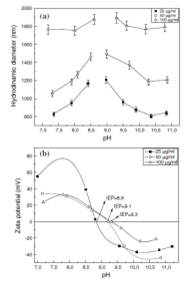
|
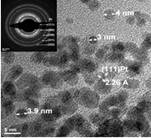
Highlights
• The physico-chemical properties of ZnO-NPs with median diameter of 10 nm, used for coating glass surfaces to achieve a durable UV light absorbance, were analyzed.
• The dispersion media influence on the nanoparticle agglomeration/ aggregation state will be discussed, the cumulate method DLS results being correlated with direct TEM visualizations. |
|
| 4. “Synchrotron X-ray diffraction analysis for quantitative defect evaluation in GaP/Si nanolayers”, T. Nguyen Thanh, C. Robert, A. Letoublon, C. Cornet, T. Quinci, E. Giudicelli, S. Almosni, N. Boudet, A. Ponchet J. Kuyyalil, M. Danila, O. Durand, N. Bertru, A. Le Corre, Thin Solid Films 541, 36–40, 2013 (pdf) |
5. “Influence of Utltrasounds on Structural and Morphological Properties of Pbs Deposited on Glass Substrate”, V. Popescu, D. Raducanu, A. Dinescu, M. Danila, G. L. Popescu, Chalcogenide Letters 10(5), 159 – 165, 2013 (pdf)
|
| 6. “Isocyanate functionalized graphene/P3HT based nanocomposites”, A. C. Obreja, D. Cristea, R. Gavrila, V. Schiopu, A. Dinescu, M. Danila, F. Comanescu, Applied Surface Science276 458– 467, 2013 (pdf) |
| 7. “L-lactic acid biosensor based on multi-layered graphene”, A. Radoi, A. C. Obreja, S. A. V. Eremia, A. Bragaru, A. Dinescu, G.-L. Radu, Journal of Applied Electrochemistry, 43 (10), 985-994, 2013 (pdf) |
| 8. “Structural investigation of austenitic stainless steel layers obtained by laser surface alloying”, R. I. Zamfir, E. Popovici, F. Miculescu, M. Danila, A. Parau, Journal of Optoelectronics and Advanced Materials15 (3 – 4), 305 – 310, 2013 (pdf) |
| 9. “Sol-gel synthesis and optical properties of ZnO powder”, A. Matei, L. Dumitrescu, I. Cernica, V. Schiopu, A. Dinescu, M. Danila, I. Mihalache, I. Manciulea, Journal of Optoelectronics and Advanced Materials 15 (7 – 8), 703 – 706, 2013 (pdf) |
| 10. “Influence of PdHx formation ability on hydrogen sensing properties of palladium-carbonaceous films”, Ewa Kowalskaa, Elzbieta Czerwosz, Ryszard Diduszko, Anna Kaminska, Mihai Danila, Sensors and Actuators A203, 434– 440, 2013 (pdf) |
| 11.“Effect of the sublayer thickness and furnace annealing on the crystallographic structure and grain size of nanocrystalline ZnxCd1-xSe thin films”, D.D. Nesheva, I.E. Bineva, M. Danila, A. Dinescu, Z.M. Levi, Z.I. Aneva, R. Muller, Bulgarian Chemical Communications, Proceedings of the Jubilee Scientific Session on “Interdisciplinary Chemistry”, 45, Special Issue B, 11-17 2013 (pdf) |
| |
 |
| |
|
| 2012 |
|
| |
1. “Design, fabrication and characterization of low-Impedance 3D Electrode Array System for Neuro-Electrophysiology”, M. Kusko, F. Craciunoiu, B. Amuzescu, F. Halitzchi, T. Selescu, A. Radoi, M. Popescu, M. Simion, A. Bragaru, T. Ignat, Sensors, 12 (12), 16571-16590, 2012 (pdf)
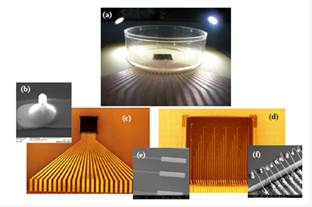
|
Highlights
• A novel fabrication process flow has been proposed to obtain Si-based multi-electrode array chips with individually addressed 3D electrodes.
• Various electrode shapes, essentially achieved by fine-tuning of the Si etching methods and their related parameters were obtained.
• Impedance spectroscopy results indicate that the impedance modulus features the lowest values for the high aspect ratio electrodes, more than sixty-fold lower compared to the planar ones, and thus, stimulation currents up to ±500 μA could be delivered. |
|
| 2. “The role of the substrate material type in formation of laser induced periodical surface structures on ZnO thin films”, M. Zamfirescu*, A. Dinescu, M. Danila, G. Socol, C. Radu, Applied Surface Science 258, 9385– 9388, 2012 (pdf) |
| 3. “Ce, Gd Codoped YAG Nanopowder for White Light Emitting Device”, V. Schiopu, A. Matei, A. Dinescu, M. Danila, I. Cernica, Journal of Nanoscience and Nanotechnology, 12 (11), 8836-8840, 2012 (pdf) |
| |
 |
| |
|
| 2011 |
|
| |
1. “Nanostructure and Internal Strain Distribution in Porous Silicon”, M. Miu, M. Danila, I. Kleps, A. Bragaru, M. Simion, Journal of Nanoscience and Nanotechnology 11, 9136-9142, 2011 (pdf)
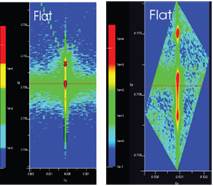
|
Highlights
• Symmetrical and asymmetrical rocking curves obtained by high-resolution X-ray diffraction completed with reciprocal space maps (RSMs) support our approach, being clearly shown that the PS film in-depth contains two layers—bulk and highly strained superficial layer, with a graded strain inter-layer.
• It has been demonstrated that, for advanced MEMS applications, an additional etching process is necessary, being adequate to eliminate the highly strain PS top-layer and to improve the quality of complex devices. |
|
2. “Detection of Human Papilloma Viruses Using Nanostructurated Silicon Support in Microarray Technology”, M. Simion, L. Savu, A. Radoi, M. Miu, A. Bragaru, Journal of Nanoscience and Nanotechnology11, 9102-9109, 2011 (pdf)
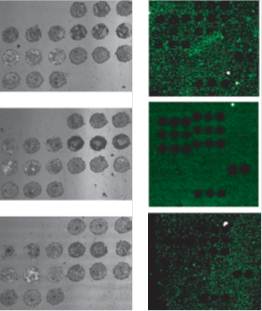
|
Highlights
• Nanostructured porous silicon surfaces with pore size 5–7 nm were tested as potential substrates for HPV DNA detection.
• The microarrayed porous silicon surfaces with ssDNA provide a low surface background and high immobilization efficiency.
• A DNA improved immobilization followed by good hybridization process for all probe with e-beam irradiation was observed, but the best hybridization rate was obtained for nano-PS support without chemical modification.
|
|
3. “Graphene analogy to electromagnetic field propagation”, I. Mihalache, D. Dragoman, Journal of Optical Society of America B – Optical Physics 28(7), 1746-1751, 2011 (pdf)
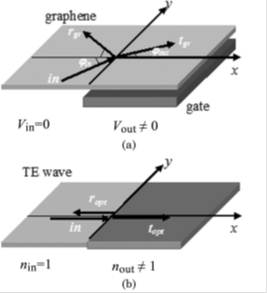
|
Highlights
• We have demonstrated that regions with different electrostatic potentials in graphene can have the same transmission probability as the transmittance of layered structures in optics illuminated with normally incident TE waves if the incidence angle of electrons in graphene and the width of the gated region are appropriately chosen.
• The quantitative analogy established in this paper can be useful for designing optical structures that correspond to graphene-based devices.
|
|
| 4. „Microstructural studies of platinum nanoparticles dispersed in Nafion membrane”, A. Bragaru, E. Vasile, M. Kusko, M. Danila, M. Simion, M. Leca, Optoelectronics and Advannced Materials - Rapid Communications, 5(11), 1190-1195, 2011 (pdf) |
| 5. “Electrochemical investigation of a glassy carbon electrode modified with carbon nanotubes decorated with (poly)crystalline gold”, A. Radoi, S.-C. Litescu, S. A. V. Eremia, M. Miu, M. Danila, A. Dinescu, G.-L. Radu, Microchimica Acta, 175 (1-2), 97-104, 2011 (pdf) |
6. “1100-nm InGaAs/(Al)GaAs quantum dot lasers for high power applications”, E.-M. Pavelescu, C. Gilfert, P. Weinmann, M. Danila, A. Dinescu, M. Kamp, J.-P. Reithmaier, Journal of Physics D -Applied Physics, 44, 145104, 2011 (pdf) |
| 7. "Biodegradation of Poly(vinyl alcohol) and Bacterial Cellulose Composites by Aspergillus niger", A. Stoica-Guzun, L. Jecu, A. Gheorghe, I. Raut, M. Stroescu, M. Ghiurea, M. Danila, I. Jipa, V. Fruth, Journal of Polymers and the Environment 19(1), 69-79, 2011 (pdf) |
| 8. “Characterization of microdevices for ferrous chloride separation for biosensing applications”, M. Carp, R. Mueller, L. Draghiciu, R. Voicu, M. Danila, Sensors and Actuators A – Physical, 171 (1), 26-33, 2011 (pdf) |
| 9. “Synthesis of Titanium Nitride Film by RF Sputtering”, S. Bellucci, S. Bini, F. Micciulla, A. Dinescu, M. Danila, Nanoscience and Nanotechnology Letters 3 (6), 856-864, 2011 (pdf) |
| 10. “Construction, Activation and Modification of Platinum Microelectrodes for (Bio)Sensors Development”, O.I. Covaci, B. Bucur, L. Galateanu, F. Craciunoiu, G.L. Radu, Digest Journal of Nanomaterials and Biostructures 6 (2) 731-738, 2011 (pdf) |
| 11. “Nanostructured Film of Indium Phosphide as Biosensor in 1D Array Electrowetting System”, L. Sirbu, I. Voda, D. Esinenco, S. Gangan, R. Muller, R. Voicu, M. Danila, L. Ghimpu, I. M. Tiginyanu, V. Ursaki, Romanian Journal of Information Science and Technology, 14 (4), 299–308, 2011 (pdf) |
| 12. “Optical Properties of CUXS Nano-powders”, A. E. Pop, V. Popescu, M. Danila, M. N. Batin, Chalcogenide Letters 8(6), 363 – 370, 2011 (pdf) |
| |
 |
| |
|
| 2010 |
|
| |
1. “Study of Nanocomposite iron/Porous Silicon Material”, M Miu, I Kleps, T. Ignat, M. Simion, A. Bragaru, Journal of Alloys and Compounds 496 (1-2), 265-268, 2010 (pdf)
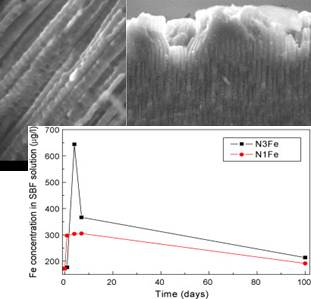
|
Highlights
• Two impregnation processes of porous structure with iron ions or iron oxides have been studied: iron electrochemical deposition and iron salts deposition and melting, both followed by thermal treatments.
• The study of release process of Fe from porous matrix during the samples storage in SBF support the assumption that the metals is impregnated both in pores and in Si skeleton and the rate of delivery depends on the strength of chemical bonds. |
|
2. „Study of CRP immobilization on nanostructured silicon”, M Simion, L Ruta, M Matache, I Kleps, M Miu, A Bragaru, T Ignat, Materials Science and Engineering: B, 169 (1-3), 67-72, 2010 (pdf)
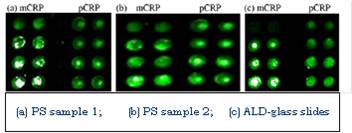
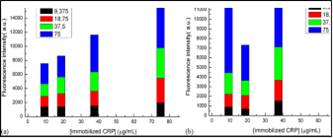
|
Highlights
• Nanostructured porous silicon surfaces were fabricated and their ability to efficiently immobilize in an active form the C-reactive protein and the monoclonal and polyclonal anti-human CRP antibodies was tested.
• Comparative analysis of the attachment degree and preservation of the biomolecules activity on the silicon surfaces and functionalized glass slides is also described.
• The microarrayed porous silicon surfaces with proteins and antibodies provide a low surface background and high immobilization efficiency. |
|
3. “Electrochemical characterization of BSA/11-mercaptoundecanoic acid on Au electrode”, T Ignat, M Miu, I Kleps, A Bragaru, M Simion, M Danila, Materials Science and Engineering B, 169 (1-3), 55-61, 2010 (pdf)
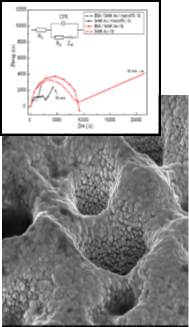
|
Highlights
• Nanostructured gold layers of 200nm thickness have been prepared on both, flat and macroporous silicon (macroPS) substrates.
• Deposition of alkanethiols and proteins on both flat- and nano-Si was monitored by Raman spectroscopy, and was further confirmed by cyclic voltammetry and impedance spectroscopy.
• Raman measurement results show a better enhancement signal when nanostructured gold is deposited on the Si substrate subjected to a previous microstructuration process (macroPS).
• Electrochemical characterization techniques relieve improved characteristics for nanostructured Au (1 1 1) deposited on Si (flat surface), both investigated structures being suitable for impedance biosensors.
|
|
4. „Electrocatalytic Activity of Platinum Nanoparticles Supported on nanoSilicon”, M. Miu, I. Kleps, M. Danila, T. Ignat, M. Simion, A. Bragaru, A. Dinescu, Fuel Cells 10 (2), 259 - 269, 2010 (pdf)
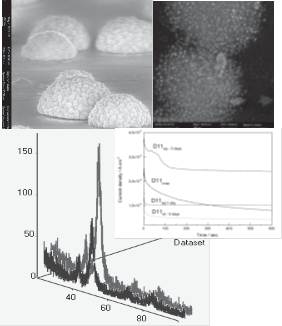
|
Highlights
• New metal/semiconductor assemblies have been developed and nanocatalyst distribution on/inside of nanoSi matrix has been achieved using both physical and chemical methods.
• The X-ray diffraction patterns show that the texture of chemically deposited metallic nanoparticles is strongly influenced by those of the Si substrate, which represents a clearly indication that crystallisation of Pt took place at the beginning inside the pores, and then continues on the surface.
• The electrochemical tests demonstrate that the nanoPt/nanoSi systems preserve good electrocatalytic performances in relation with the small quantity of Pt catalyst being a step forward in optimisation of miniaturised fuel cell fabrication technology. |
|
| 5. „Nanostructured silicon particles for medical applications”, I. Kleps, T. Ignat, M. Miu, F. Craciunoiu, M. Trif, M. Simion, A. Bragaru, A. Dinescu, Journal of Nanoscience and Nanotechnology, 10, 2694–2700, 2010 (pdf) |
| 6. “Hybrid electro-optical nanosystem for neurons investigation”, M. Miu, I. Kleps, F. Craciunoiu, M. Simion, A. Bragaru, T. Ignat, Solid State Sciences,12, 1917-1922, 2010 (pdf) |
| 7. “Ultrabroadband photodetection based on graphene ink”, A. Radoi, A. Iordanescu, A. Cismaru, M. Dragoman, D. Dragoman, Nanotechnology, 21 (45) 455202 (5pp), 2010 (pdf) |
| 8. “Optical linear and third-order nonlinear properties of nano-porous Si“, T. Bazaru, V. I. Vlad, A. Petris, M. Miu, Journal of Optoelectronics and Advanced Materials, 12(1), 43 – 47, 2010 (pdf) |
| 9. “Layout for millimeter wave Composite Right/Left Handed devices obtained by femtosecond laser ablation”, M. Zamfirescu, G. Sajin, A. Bunea, F. Craciunoiu, S. Simion, R. Dabu, Journal of Optoelectronics and Advanced Materials, 12(3), 686 – 691, 2010 (pdf) |
| 10. "Platinum Nanoparticles for Nanocomposite Membranes Preparation", A. Bragaru, M. Miu, M. Simion, A. Iordanescu, M. Danila, A. Radoi, A. Dinescu, Romanian Journal of Information Science and Technology13(4) 350-357, 2010 (pdf) |
| 2009 |
|
| |
1. “Study of the Micro- and Nanostructured Silicon for Biosensing and Medical Applications”, I. Kleps, M. Miu, M. Simion, T. Ignat, A. Bragaru, F. Craciunoiu, M. Danila, Journal Biomedical Nanotechnology5, 300–309, 2009 (pdf)
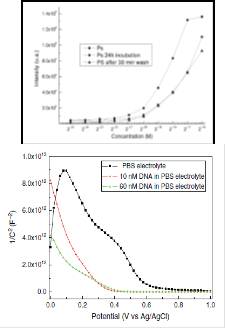
|
Highlights
• We have demonstrated that different morphologies of PS layers have an important role in biomolecule detection, due to its large internal surface combined with specific electro-optical properties, being in the same time support for immobilization of complementary biomolecules as well as transducer for biochemical interactions.
• PS substrate has been used for optimisation microarray imaging technique parameters.
• We have shown how electrochemical impedance spectroscopy (EIS), next to surface plasmon resonance (SPR), could become a reliable technique for analyzing the changes in interfacial properties of modified active surfaces induced by the binding of charged molecules.
|
|
2. “Porous Silicon Used as Support for Protein Microarray”, M. Simion, L. Ruta, C. Mihailescu, I. Kleps, A. Bragaru, M. Miu, T. Ignat, Ion Baciu, Superlattices and Microstructures, 46, 69-76, 2009 (pdf)
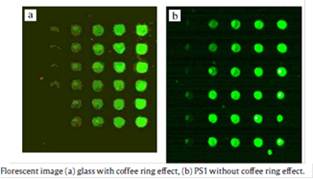
|
Highlights
• We have demonstrated that the branched structure of the pores, as in PS1 sample is suitable to immobilize proteins, the spots are very good defined and don't have the ``coffee ring'' effect, indicating a good homogeneity of the spot and no possibility to spread on the surface.
• Moreover, the binding between the protein and the surface is very strong, proved by the constant fluorescence signal after the washing procedure. |
|
3. “Nanostructured Au/Si Substrate for Organic Molecule SERS Detection”, T Ignat, Roberto Munoz, I Kleps, I Obieta, M Miu, M Simion, M Iovu, Superlattices and Microstructures, 46, 451–460, 2009 (pdf)
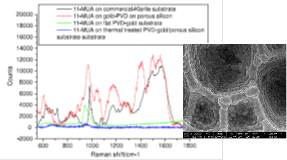
|
Highlights
• We have demonstrated the excellent SERS properties of Au/macroporous silicon substrate with 1 mm geometric cavities for 11-MUA excited with a 785 nm laser line, similar to those of a commercial Klarite substrate.
• The geometric cavities enhance the local electromagnetic field, resulting in approximately one order of magnitude higher SERS enhancement over the nanostructured commercial substrate. |
|
4. “Metallic-Semiconductor Nanosystem Assembly for Miniaturized Fuel Cell Applications”, M. Miu, M. Danila, T. Ignat, F. Craciunoiu, I. Kleps, M. Simion, A. Bragaru, A. Dinescu, Superlattices and Microstructures, 46, 291–296, 2009 (pdf)
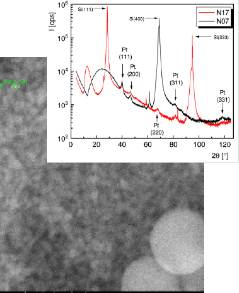
|
Highlights
• Two types of Si based catalyst support nanomaterials have been studied for further integration in a miniaturized DMFC: (i) oxidized porous silicon layers; (ii) silica nanoparticles.
• A simple chemical deposition process was used for Pt impregnation and it was demonstrated that the substrate structures influence the dimensions and also the crystalline structures of metallic particles.
• The advantages of porous structure is that it allows Pt to grow on surface and also inside the nanostructured layer and also that it can be subjected to additional grafting processes to mimic the supposed structure of Nafion membranes.
|
|
| 5. “SERS-Active Substrate based on Macroporous Silicon“, T. Ignat, R. Munoz, I. Kleps, M. Miu, I. Obieta, M. Simion, Romanian Journal of Information Science and Technology, 12(4), 496-503, 2009 (pdf) |
| 6. "Porous/Gold surface Preparation for Protein Microarray Application", M. Simion, L. Ruta, I. Kleps, D. Stan, A. Bragaru, M. Miu, T. Ignat, A. Dinescu, M. Matache, Romanian Journal of Information Science and Technology, 12(3), 385-393, 2009 (pdf) |
| 7. “A Method for on-Wafer Experimental Characterization of a 4-Port Circuit, Using a 2-Port Vector Network Analyzer”, S. Simion,R. Marcelli, G. Sajin, G. Bartolocci, F. Craciunoiu, Romanian Journal of Information Science and Technology, 12(3), 394-401, 2009 (pdf) |
| 8. “6.3 GHz Film Bulk Acoustic Resonator Structures Based on a Gallium Nitride/Silicon Thin Membrane”, A. Müller, D. Neculoiu, G. Konstantinidis, A. Stavrinidis, D. Vasilache, A. Cismaru, M. Danila, M. Dragoman, G. Deligeorgis, K. Tsagaraki, Electron Devices Letters, 30(8), 799-801, 2009 (pdf) |
| 2008 |
|
| |
1. „Study of the Nanostructurated Silicon Chemical Functionalization”, A. Bragaru, M. Simion, M. Miu, T. Ignat, I. Kleps, V. Schiopu, A. Avram, F. Craciunoiu, Romanian Journal of Information Science and Technology, 11(4), 397-407, 2008 (pdf) |
| 2. “Microfluidics Silicon Structure for Electrophoresis Separation of DNA Fragments”, M. Simion, I. Kleps, F. Craciunoiu, L. Savu, M. Miu, A. Bragaru, Sensor Letters, 6(4), 585–589, 2008 (pdf) |
| 3. “Femtosecond Laser Fabrication of Metamaterials for High Frequency Microwave Devices”, M. Zamfirescu, R. Dabu, M. Dumitru, G. Sajin, F. Craciunoiu, Journal of Laser Micro Nanoengineering 3(1), 5-8 2008 (pdf) |
| 4. “Plasma Surface Modification for Selective Hydrophobic Control”, M. Avram, A. M. Avram, A. Bragaru, A. Ghiu, C. Iliescu, Romanian Journal of Information Science and Technology, 11 (4), 409-422, 2008 (pdf) |
| 2007 |
|
| |
1. “Nanoporous silicon matrix used as biomaterial”, M. Simion, I. Kleps, T. Neghina, A. Angelescu, M. Miu, A. Bragaru, M. Danila, E. Condac, M. Costache, L. Savu, Journal of Alloys and Compounds, 434-435, 830-832, 2007 (pdf) |
| 2. “Gold and silver/Si nanocomposite layers”, I. Kleps, M. Danila, A. Angelescu, M. Miu, M. Simion, T. Ignat, A. Bragaru, L. Dumitru, G. Teodosiu, Materials Science and Engineering C 27(5-8), 1439-1443, 2007 (pdf) |
| 3. “Development of the micro- and nanoelectrodes for cells investigation”, I. Kleps, M. Miu, F. Craciunoiu, M. Simion, Microelectronic Engineering 84 (5-8), 1744-1748, 2007 (pdf) |
| 4. "Silicon chip technology - Electrophoretic DNA analysis", M. Simion, I. Kleps, F. Craciunoiu, L. Savu, M.Miu, A. Bragaru, Romanian Journal of Information Science and Technology 10 (1), 35-41, 2007 (pdf) |
| 5. "Investigation of silver-, meso- and nanoporous silicon composite layers for biomedical applications", I. Kleps, M. Miu, M. Danila, M. Simion, T. Ignat, A. Bragaru, L. Dumitru, G. Teodosiu, Romanian Journal of Information Science and Technology, 10 (1), 97-111, 2007 (pdf) |
| |
 |
| |
| |
| Papers published in conferences proceedings ISI indexed (since 2007) |
| 2021 |
| |
“Morpho-structural and optical characterization of silicon nanowires intended for microarray substrates”, Melania A Popescu, Iuliana Mihalache, Cosmin Romanitan, Marian C Popescu, Larisa Gogianu, Monica Simion, IEEE CAS Proceedings, 265-268, 2021 (pdf) |
| |
“Detecting anomalous behavior in Si MOS capacitors”, Razvan Pascu, Gheorghe Pristavu, Mihaela Kusko, Florin Draghici, Gheorghe Brezeanu, IEEE CAS Proceedings, 103-106, 2021 (pdf) |
| |
“Studies on structural MWCNT/epoxy nanocomposites for EMI shielding applications”, C Paun, C Obreja, F Comanescu, V Tucureanu, O Tutunaru, C Romanitan, O Ionescu, DE Gavrila, V Manescu Paltanea, V Stoica, G Paltanea, IOP Conference Series: Materials Science and Engineering 1009 012046, 2021 (pdf) |
| |
“PLA nanocomposites with antimicrobial action, based on olive fruit polyphenols and citrus fruit extracts encapsulated in Maltodextrin”, IV Tudose, I Rosca, C Romanitan, ON Ionescu, K Petrotos, S Zaoutsos, MP Suchea, E Koudoumas, IEEE CAS Proceedings, 269-272, 2021 (pdf) |
| |
“Testing and characterization of a biosensor for the detection of infections in tissue based on Rh6G and AuNP functionalized with BSA”, L Draghiciu, C Parvulescu, G Craciun, C Voitincu, A Albu, C Romanitan, IEEE CAS Proceedings, 295-298, 2021 (pdf) |
| 2020 |
| |
“Electrical defects in grown oxide on SiC and from the oxide/SiC interface”, Razvan Pascu, Mihaela Kusko, Octavian Ionescu, Gheorghe Pristavu, Gheorghe Brezeanu, IEEE CAS Proceedings, 37-40, 2020 (pdf) |
| |
“Biogenic synthesis of silver nanoparticles using sea buckthorn fruits aqueous extract and antibacterial activity against Staphylococcus aureus and Pseudomonas aeruginosa”, Petruta Preda, Marioara Avram, Diana Stan, Cosmin Romanitan, Gabriel Craciun, Monica Simion, Iuliana Mihalache, Anton Ficai, IEEE CAS Proceedings, 203-206, 2020 (pdf) |
| |
“Biogenic synthesis of silver nanoparticles using sea buckthorn fruits aqueous extract and antibacterial activity against Staphylococcus aureus and Pseudomonas aeruginosa”, Petruta Preda, Marioara Avram, Diana Stan, Cosmin Romanitan, Gabriel Craciun, Monica Simion, Iuliana Mihalache, Anton Ficai, IEEE CAS Proceedings, 203-206, 2020 (pdf) |
| |
“A study for an aluminum electro-thermally actuated U-shaped microtweezer”, R-C Voicu, M Pustan, C Birleanu, R Gavrila, C Romanitan, O Tutunaru, A Cismaru, IOP Conf. Ser.: Mater. Sci. Eng. 724 012053, 2020 (pdf) |
| |
“AFM studies on surface morphology evolution after annealing of V2O5 thin films grown by spray pyrolysis”, C Pachiu, M Carp, K Mouratis, IV Tudose, C Romanitan, O Tutunaru, S Couris, E Koudoumas, MP Suchea, IEEE CAS Proceedings, 191-194, 2020 (pdf) |
| |
“Medical bio sensing of collagen gold nanoparticles conjugated to improve the dermis and joints”, L Draghiciu, T Ignat, C Romanitan, R Gavrila, I Mihalache, C Parvulescu, IEEE CAS Proceedings, 187-190, 2020 (pdf) |
| 2017 |
| |
“As2Se3 thin films deposited by frequency assisted thermal evaporation - morphology and structure”, T. Hristova-Vasileva, I. Bineva, A. Dinescu, M. Danila, D. Arsova, IOP Conf. Series: Journal of Physics: Conf. Series 794, 012015, 2017 (pdf) |
| |
“Structural and morphological characterization of ternary nanocrystalline Cu-In-S thin films prepared by laser ablation”, I. Bineva, B. Pejova, V. Mihailov, A. Dinescu, M. Danila, S. Karatodorov, IOP Conf. Series: Journal of Physics: Conf. Series 794 012019, 2017 (pdf) |
| |
| 2016 |
| |
„SiO2/SiC interface improvements using an oxidized thin film of a-Si”, Razvan Pascu, Florea Craciunoiu, Mihaela Kusko, Gheorghe Pristavu, Gheorghe Brezeanu, IEEE CAS Proceedings, 123-126, 2016; |
| |
“Reproducible functionalization of silicon substrates intended for biomedical applications”, Melania Banu, Antonio Radoi, Monica Simion, Mihaela Kusko, IEEE CAS Proceedings, 151-155, 2016. |
 |
| 2015 |
| |
1. “Electrical characterization of Ni-silicide Schottky contacts on SiC for high performance temperature sensor”, Razvan Pascu, Gheorghe Pristavu, Gheorghe Brezeanu, Florin Draghici, Marian Badila, Ion Rusu, Florea Craciunoiu, Materials Science Forum 821-823 (2015) 436-439 (pdf) |
| |
2."Barrier non-uniformity of annealed Ni/4H-SiC Schottky contacts with temperature", Gheorghe Pristavu, Gheorghe Brezeanu, Marian Badila, Anca Vasilica, Razvan Pascu, in Ph.D. Research in Microelectronics and Electronics (PRIME), 157-160, 2015 (pdf) |
| |
3.“SiO2/4H-SiC interface states reduction by POCl3 post-oxidation annealing”, Răzvan Pascu, Florea Craciunoiu, Mihaela Kusko, Mihai Mihăilă, Gheorghe Pristavu, Marian Badila, Gheorghe Brezeanu, IEEE CAS Proceedings, 255-258, 2015 (pdf) |
| |
4. "High temperature Sensors Based on Silicon Carbide (SiC) Devices", Gheorghe Brezeanu, Marian Badila, Florin Draghici, Razvan Pascu, Gheorghe Pristavu, Florea Craciunoiu, Ioan Rusu, IEEE CAS Proceedings, 3-10, 2015 |
| |
5. "High Voltage Freewheeling Diodes in an Extended Capability LED Driving Application", Gheorghe Pristavu, Anca Vasilica, Vlad Anghel, Razvan Pascu, Gheorghe Brezeanu, Florin Draghici, IEEE CAS Proceedings, 175-178, 2015 |
 |
| 2014 |
| |
1.“Temperature behavior of 4H- SiC MOS capacitor used as a gas sensor”, Razvan Pascu, Gheorghe Pristavu, Marian Badila, Gheorghe Brezeanu, Florin Draghici, Florea Craciunoiu, IEEE CAS 2014 Proceedings,185 – 188, 2014 (pdf)
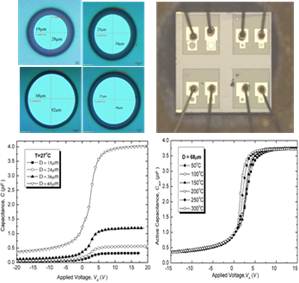
|
Highlights
• A layout for the MOS structure with four circular patterns with diameters of 18, 24, 36, and 68 µm, respectively, have been delimited in the passivation oxide;
• An alternative bonding technology (a gold wire) for connecting the chip pad to the package anode terminal was used as packaging solution.
• A hump can be seen in the data, when the bias is swept from depletion to accumulation, due to electron trapping in interface states. The capacitor active area’s effect is evidenced. The temperature produces a negative voltage shift in the depletion region of the C-V curves, only. A proper stability of these characteristics for the whole measured temperature range is noted. |
|
| |
2. “Chemical Characterization of Porous Silicon”,Mihaela Kusko*, Iuliana Mihalache, Handbook of Porous Silicon, Editors: Leigh Canham, Springer International Publishing Switzerland, ISBN: 978-3-319-04508-5, 2014 (pdf) |
| |
3.“High Temperature SiC-Sensors”, G. Pristavu, F. Draghici, M. Badila, G. Brezeanu, R. Pascu, F. Craciunoiu, 2014 IEEE 20th International Symposium for Design and Technology in Electronic Packaging (SIITME), 329-332, 2014 (pdf) |
| |
4.“Two Packaging Solutions for High Temperature SiC Diode Sensors”, G. Brezeanu, F. Draghici, M. Badila, F. Craciunoiu, G. Pristavu, R. Pascu, F. Bernea, Materials Science Forum 778-780, 1063-1066, 2014 (pdf) |
| |
5.“The effect of annealing in nitrogen atmosphere on the structure, photoluminescence and electrical properties of Li and Cu doped sol-gel ZnO films”, A. Danciu, I. Mihalache, M. Danila, B. Bita, R. Plugaru, IEEE CAS 2014 Proceedings, 77 – 80, 2014 (pdf) |
| |
6.“Fabrication of spiral phase plates for optical vortices”, Rebeca Tudor, Mihai Kusko, Cristian Kusko, Florea Craciunoiu, Andrei Avram, Dan Vasilache, IEEE CAS 2014 Proceedings, 139 – 142, 2014 (pdf) |
| |
7. “Ordered shapes of the CVD SiO2 evidenced by wet etching”, Angela Baracu, Razvan Pascu, Florea Craciunoiu, IEEE CAS 2014 Proceedings, 121 – 124, 2014 (pdf) |
| |
 |
| 2013 |
|
| |
1. “A promising technology of Schottky diode based on 4H-SiC for high temperature application”, R. Pascu, F. Craciunoiu, M. Kusko, IEEE Proceeding of PRIME 2013, 297-300, 2013 (pdf)
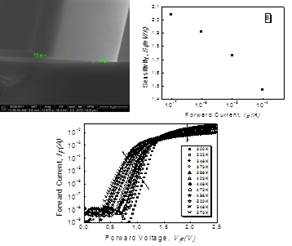
|
Highlights
• Oxide ramp termination - a ramp angle lower than 5° assures an uniform distribution of the current density and a value of the breakdown voltage close to the theoretical values
• The Schottky diodes electrical tests demonstrate that they successfully operate in the whole range of the temperature 300-573K.
• The sensitivity of the sensor is in range of S = [1.47-2.04] mV/K and it decreases with current increasing |
|
| 2. “4H-SiC Schottky contact improvement for temperature sensor applications”, F. Draghici, M. Badila, G. Brezeanu, G. Pristavu, I. Rusu, F. Craciunoiu, R. Pascu, IEEE CAS 2013 Proceedings,163 – 166, 2013 |
| 3. “Wavelet solution of the Schrodinger equation for a triangular potential barrier and applied results on a MOM tunnel junction”, E.-S. Malureanu, F. Craciunoiu, IEEE CAS 2013 Proceedings, 65 – 68, 2013 |
| 4. “Porous and RF sputtering InP for portable THZ-TDS in pharmaceutical and medical applications”, L. Sirbu, L. Ghimpu, M. Danila, R. Muller, A. Matei, F. Comanescu, A. Ionescu, O. Grigore, T. Dascalu, A. Sarua,IEEE CAS 2013 Proceedings, 69 – 72, 2013 |
| 5. “Steering capability of a mm-WAVE lefthanded transmission line antenna”, G.I. Sajin, I.A. Mocanu, F. Craciunoiu, S. Ciocan, IEEE CAS 2013 Proceedings, 101 – 104, 2013 |
| 6. “SH-SAW sensors on Langasite for mass detection in liquid media”, A. Baracu, M. Nedelcu, F. Craciunoiu, R. Voicu, R. Muller, IEEE CAS 2013 Proceedings, 115 – 118, 2013 |
| 7. “Silicon plasma processing for antireflective micro - textured surfaces with applications for solar cells”, R. Rebigan, A. Avram, F. Craciunoiu, R. Tomescu, E. Budianu, M. Purica, M. Popescu, IEEE CAS 2013 Proceedings, 119 – 122, 2013 |
| 8. “Effects of the preparation conditions and furnace annealing on the structure and morphology of Zn0.8Cd0.2Se thin films”, I. Bineva, A. Dinescu, D. Nesheva, M. Danila, Z. Aneva, Z. Levi, R. Muller, IEEE CAS 2013 Proceedings, 129 – 132, 2013 |
| |
 |
| 2012 |
|
| |
1. “Nanomaterials: Fabrication and investigation of dispersions for toxicological studies”, T. Ignat, M. Kusko, A. Dinescu, M. Danila, A. Bragaru, M. Simion, IEEE CAS 2012 Proceedings, 309 – 312, 2012 (pdf) |
| 2. “The effect of the post-metallization annealing of Ni/n-type 4H-SiC schottky contact”, R. Pascu, F. Craciunoiu, M. Kusko, F. Draghici, A. Dinescu, M. Danila, IEEE CAS 2012 Proceedings, 457 – 460, 2012 (pdf) |
| 3. “Porous silicon decorated metallic nanoparticles for growing vertically aligned carbon nanotubes”, L.M. Veca, F. Craciunoiu, M.S. Kusko, M. Danila, A. Dinescu, IEEE CAS 2012 Proceeding, 79-83, 2012 (pdf) |
| 4. “Deposition condition effect over multilayers nanocomposite membrane growth”, A. Bragaru, M.S. Kusko, M. Simion, T. Ignat, M. Danila, F. Craciunoiu, IEEE CAS 2012 Proceeding, 179-183, 2012 (pdf) |
| 5. “48 GHz Zeroth Order Resonance Metamaterial Antenna on Alumina Substrate”, G. Sajin, F. Craciunoiu, A. Dinescu, I. A. Mocanu, Proceedings of the 16th Mediterranean Electrotechnical Conference, 46 – 49, 2012 |
| |
 |
| 2011 |
|
| |
1. “Porous silicon-obtaining, properties and applications”, F. Craciunoiu, M. Miu, Elektronika 8 , 24-27, 2011
|
| 2. “Laser ablated millimeter wave metamaterial antenna”, A.-C. Bunea, F. Craciunoiu, M. Zamfirescu, R. Dabu, G. Sajin, IEEE CAS 2011 Proceeding, 185-188, 2011 (pdf) |
| 3. „Fabrication of micro-platform for biological cell investigation”, M.S. Kusko, F. Craciunoiu, F. Gheorghe, M. Simion, A. Bragaru, A. Iordanescu, R. Pascu, IEEE CAS 2011 Proceeding, 109-113, 2011 (pdf) |
| 4. „Fabrication and in vitro testing of porous silicon microcarriers”, A. Bragaru, M. S. Kusko, M. Simion, A. Iordanescu, R. Pascu, M. Danila, F. Craciunoiu, M. Diaconu, IEEE CAS 2011 Proceeding, 117-123, 2011 (pdf) |
| 5. „Nanostructured indium phosphide used in electrowetting system for biosensor applications”, L. Sirbu, I. Voda, D. Esinenco, R. Muller, R. Voicu. M. Danila, L. Ghimpu, I. M. Tiginyanu, V. Ursaki, IEEE CAS 2011 Proceeding, 237-241, 2011 (pdf) |
| 6. „Functionalized graphene/poly 3-hexyl thiophene based nanocomposites”,A.C. Obreja, D. Cristea, R. Gavrila, V. Schiopu, A. Dinescu, M. Danila, F. Comanescu, IEEE CAS 2011 Proceeding, 27-31, 2011 (pdf) |
| 7. „Structural investigation of P3HT-PCBM-Graphene films”, L.M. Veca, R. Gavrila, E. Vasile, M. Purica, M. Danila, IEEE CAS 2011 Proceeding, 53-57, 2011 (pdf) |
| 8. „High temperature sensor based on SiC Schottky diodes with undoped oxide ramp termination”,R. Pascu, F. Draghici, M. Badila, F. Craciunoiu, G. Brezeanu, A. Dinescu, I. Rusu, IEEE CAS 2011 Proceeding, 379-383, 2011 (pdf) |
| 9. „Laser surface nanostructuring of platinum”,M. Zamfirescu, A. Dinescu, F. Craciunoiu, C. Radu, R. Stoian, IEEE CAS 2011 Proceeding, 35-39, 2011 (pdf) |
| 10. "4H-SiC Schottky Diodes for Temperature Sensing Applications in Harsh Environments", G. Brezeanu, F. Draghici, F. Craciunioiu, C. Boianceanu, F. Bernea, F. Udrea, D. Puscasu, I. Rusu, Silicon Carbide and related materials 2010, Book Series: Materials Science Forum 679-680, 575-578, 2011 (pdf) |
| |
 |
| 2010 |
|
| |
1. “Optical characterization of supported gold nanoparticles for plasmonic biosensors”, O. Pluchery, E. Lacaze, M. Simion, M. Miu, A. Bragaru, A. Radoi, IEEE CAS 2010 Proceeding, 159- 162, 2010 (pdf) |
| 2. “Nanocomposite membranes based on platinum nanoparticles dispersed in polymeric matrix”, A. Bragaru, M. Miu, M. Simion, A. Iordanescu, M. Danila, A. Radoi, A. Dinescu, IEEE CAS 2010 Proceeding, 95- 98, 2010 (pdf) |
| 3. “Graphene ink photodetector for UV-Vis and NIR domain”, A. Radoi, A. Cismaru, A. Iordanescu, M. Dragoman, IEEE CAS 2010 Proceeding, 73- 76, 2010 (pdf) |
| 4. “CNT films grown on nanoporous silicon”, E. Czerwosz, E. Kowalska, M. Kozłowski, H. Wronka, F. Craciunoiu, A. Dinescu, M. Miu, IEEE CAS 2010 Proceeding, 81 – 84, 2010 (pdf) |
| 5. “Pd-C films grown on SiO2/Si and Si substrates”, R. Diduszko, E. Czerwosz, E. Kowalska, M. Kozlowski, R. Nietubyć, F. Craciunoiu, M. Danila, IEEE CAS 2010 Proceeding, 371- 374, 2010 (pdf) |
| 6. “Topography and structure of nanocomposite C-Ni field emitters“, E. Czerwosz, I. Iwanejko, A. Kaminska, J. Rymarczyk, J. Keczkowska, M. Suchanska, F. Craciunoiu, F. Comanescu IEEE CAS 2010 Proceeding, 91 –94, 2010 (pdf) |
| 7. “An industrial temperature probe sensor on SiC diodes”, F. Draghici, M. Badila, G. Brezeanu, I. Rusu, F. Craciunoiu, I. Enache, IEEE CAS 2010 Proceeding, 405 – 408, 2010 (pdf) |
| 8. “High power 1100 nm InGaAs/ GaAs Quantum dots Lasers”, E. M. Pavelescu, C. Gilfert, M. Danila, A. Dinescu, J. P. Reithmaier, IEEE CAS 2010 Proceeding, 173- 176, 2010 (pdf) |
| 9. "CRLH CPW Antenna on magnetically biased ferrite substrate", G. Sajin, S. Simion, F. Craciunoiu, A. A. Muller, A. C. Bunea, (2010), Journal of Electromagnetic Waves and Applications, 24, 803–814, 2010 (pdf) |
| 10. “Metamaterial Millimeter Wave Directional Coupler on silicon substrate”, G. Sajin, S. Simion, Fl. Craciunoiu, A.-C. Bunea, A.A. Muller, A. Dinescu, IEEE CAS 2010 Proceeding, 269 – 272, 2010 (pdf) |
| 11. “Millimeter Wave Metamaterial Band-Pass Filter by Femtosecond Laser Ablation”, G. Sajin, S. Simion, F. Craciunoiu, A.-C. Bunea, A. Dinescu, M. Zamfirescu, L. Neagu, R. Dabu, Proceedings of European Microwave Conference, 1393 – 1396, 2010 (pdf) |
| 12. “Ferrite Supported Steerable Antenna on Metamaterial CRLH Transmission Line”, G. Sajin, S. Simion, F. Craciunoiu, A.A. Muller, A.-C. Bunea, Proceedings of European Microwave Conference, 449 – 452, 2010 (pdf) |
| 13. “Magnetic Scanning of the Radiation Characteristic of a CRLH CPW Antenna”, G. Sajin, S. Simion, Fl. Craciunoiu, A.A. Muller, A.-C. Bunea, Proceedings of 15th IEEE Mediterranean Electrotechnical Conference, 337 – 342, 2010 (pdf) |
| 14. “Magnetically Tuned CRLH CPW Zeroth Order Antenna”, G. Sajin, S. Simion, Fl. Craciunoiu, A.A. Muller, A.-C. Bunea, (2010), Proceedings of the 15th IEEE Mediterranean Electrotechnical Conference, 1273 – 1277, 2010 (pdf) |
| 2009 |
|
| |
1. „Protein-mesoporous silicon matrix obtained by S-layer technology”, I. Kleps, T. Ignat, M. Miu, M. Simion, G. Teodosiu Popescu, M. Enache, L. Dumitru, Physica Status Solidi C 6 (7), 1605 – 1609, 2009 (pdf) |
| 2. “Metal – semiconductor nanoassemblies for improving of sensing efficiency”, M. Miu, I. Kleps, F. Craciunoiu, T. Ignat, M. Simion, A. Dinescu, A. Bragaru, M. Danila, ECS Transactions (216th ECS Meeting 2009), 25 (11) 45-55, 2009 (pdf) |
| 3. “Electrochemical Investigation of Porous Silicon/Gold System in Biological Electrolyte”, M. Simion, M. Miu, L. Cortojan, I. Kleps, L. Savu, M. Danila, A. Bragaru, ECS Transactions (216th ECS Meeting 2009), 25 (31) 59-68, 2010 (pdf) |
| 4. “Electrochemical Investigation of Porous Silicon/Gold System in Biological Electrolyte”, M. Simion, M. Miu, L. Cortojan, I. Kleps, L. Savu, M. Danila, A. Bragaru, ECS Transactions (216th ECS Meeting 2009), 25 (31) 59-68, 2010 (pdf) |
| 5. “Frequency Tuning of a CRLH CPW Antenna on Ferrite Substrate by Magnetic Biasing Field”, G. Sajin, S. Simion, F. Craciunoiu, A. Muller, A. C. Bunea, Proceedings of the European Microwave Conference, 1283 – 1286, 2009 (pdf) |
| 6. “Self-assembled monolayer of ethanthiol on gold surfaces by Quartz Crystal Microbalance”, G.V. Cimpoca, I.V. Popescu, I.D. Dulama, C. Radulescu, I. Bancuta, M. Cimpoca, I. Cernica, V. Schiopu, M. Danila, R. Gavrila, IEEE CAS 2009 Proceeding, 135 – 138, 2009 (pdf) |
| 7. "Investigation of the piezoelectric properties of the thin films by AFM", F. Craciunoiu, M. Miu, R. Gavrila, A. Dinescu, E. Hamciuc, IEEE CAS 2009 Proceeding, 99-102, 2007 |
| 2008 |
|
| |
1. “Technological fabrication of the humidity sensors on nanostructurated membranes“, A. Bragaru, M. Miu, F. Craciunoiu, I. Klpes, M. Simion, T. Ignat, IEEE CAS 2008 Proceeding 189- 192, 2008 (pdf) |
| 2. “Biohybrid surface preparation for protein/DNA microarray applications”, M. Simion, L. Ruta, I. Kleps, C. Mihailescu, A. Bragaru, M. Miu, T. Ignat, IEEE CAS 2008 Proceeding 201- 204, 2008 (pdf) |
| 3. “Silicon 3D structuring by anodization”, F. Craciunoiu, A. Dinescu, A. Bragaru, IEEE CAS 2008 Proceeding, 181- 184 (pdf) |
| 4. “Microstructural investigation of nanocrystalline FCC metals (Pt, Pt- Fe) embedded into a porous silicon”, M. Danila, M. Miu, T. Ignat, I. Kleps, M. Simion, E. Vasile, IEEE CAS 2008 Proceeding, 271- 274 |
| 5. “Mixed-monolayers with alkane thiol on gold as substrates for microarray applications”, C. Mihailescu, D. Stan, L. Ruta, B. Ion, C. Moldovan, V. Schiopu, M. Simion, R.Gavrila, IEEE CAS 2008 Proceeding, 173- 176 (pdf) |
| 6. “Preparation of SERS- active porous gold substrate”, T. Ignat, I. Kleps, M. Miu, F. Craciunoiu, A. Bragaru, M. Simion, IEEE CAS 2008 Proceeding, 197-200, 2008 (pdf) |
| 7. “Microwave Antennas With crlh Cells on Silicon Substrate”, G. Sajin, S. Simion, R. Marcelli, F. Craciunoiu, Proceedings of the 50th International Symposium “Electronics in Marine”, 211 – 214, 2008 (pdf) |
| 2007 |
|
| |
1. “Nanocomposite porous silicon layers”, I. Kleps, M. Miu, T. Ignat, M. Simion, Proceedings of the Sixteenth International Offshore and Polar Engineering Conference, by The International Society of Offshore and Polar Engineers (ISOPE) 2916- 2923, 2007 (pdf) |
| 2. “Development of a new microfluidic analysis system based on porous silicon as sensitive element”, M. Miu, A. Angelescu, I. Kleps, F. Craciunoiu, M. Simion, A. Bragaru, T. Ignat, Physica Status Solidi (c), 4(6), 2093–2097, 2007 (pdf) |
| 3. "A gray-tons derived lithography method for Si micromachining", F. Craciunoiu, IEEE CAS 2007 Proceeding, 119-122, 2007 |
| 4. “Silicon supported microwave directional coupler metamaterial approach”, G. Sajin, S Simion, R Marcelli, F. Craciunoiu, G. Bartolucci, IEEE CAS 2007 Proceeding, 241-244 |
| 5. “High Frequency Micromixing Applications: Interactions between Piezoelectric Ceramic and Biological Media”, M. Sajin, D. Petrescu, G. Sajin, F. Craciunoiu, R. Gavrila, Proceedings of the 2007 Asia-Pacific Microwave Conference, 2437 – 2440, 2007 (pdf) |
| 6. “Silicon supported microwave zeroth-order resonance antenna on metamaterial approach”, G. Sajin, S. Simion, F. Craciunoiu, R. Marcelli, G. Bartolucci Proceedings of the 2007 Asia-Pacific Microwave Conference, 221 – 224, 2007 (pdf) |
| 7. “CPW Silicon Zeroth-Order Resonance Antenna Using Composite Right/Left-Handed Transmission Lines”, G. Sajin, S. Simion, F. Craciunoiu, R. Marcelli, Proceeding of Mediterranean Microwave Symposium, 65 – 68, 2007 |
| 8. “CPW Silicon Directional Coupler Based on Composite Right/Left-Handed Transmission Lines”, S. Simion, G. Sajin, F. Craciunoiu, R. Marcelli, G. Bartolucci, Proceeding of Mediterranean Microwave Symposium, 307 – 310, 2007 |
| 9. “Resonating antenna and coupled line directional coupler based on metamatarials approach”, S. Simion, G. Sajin, F. Craciunoiu, Proceedings of the 2nd International Conference on Electronics, Computers and Artificial Intelligence, 20-MW – 25-MW, 2007 |
| 10. “Design and fabrication of MMIC coupled lines coupler consisting of Composite Right/Left-Handed transmission lines”, S. Simion, G. Sajin, F. Craciunoiu, R. Marcelli, G. Bartolucci, The International Conference on Computer as a Tool, 2073 – 2077, 2007 |
| 11. “Silicon Resonating Antenna Based on CPW Composite Left/Right-Handed Transmission Line”, S. Simion, G. Sajin, R. Marcelli, F. Craciunoiu, G. Bartolucci, Proceeding of European Microwave Week, 478 – 481, 2007 |
| 12. “CPW composite right/left-handed zeroth-order resonance antenna on silicon substrate”, S. Simion, G. Sajin, F. Craciunoiu, R. Marcelli, G. Bartolucci, Proceedings of First International Congress on Advanced Electromagnetic Materials for Microwave and Optics, 373 – 376, 2007 |
|



